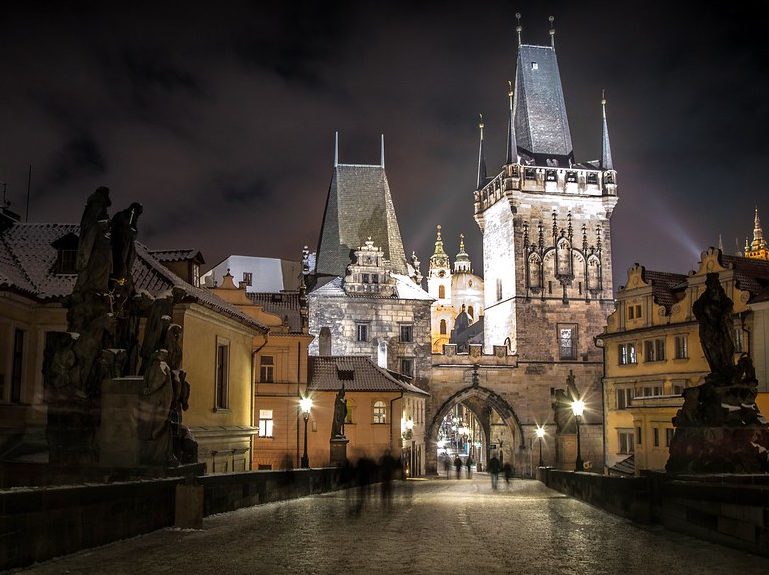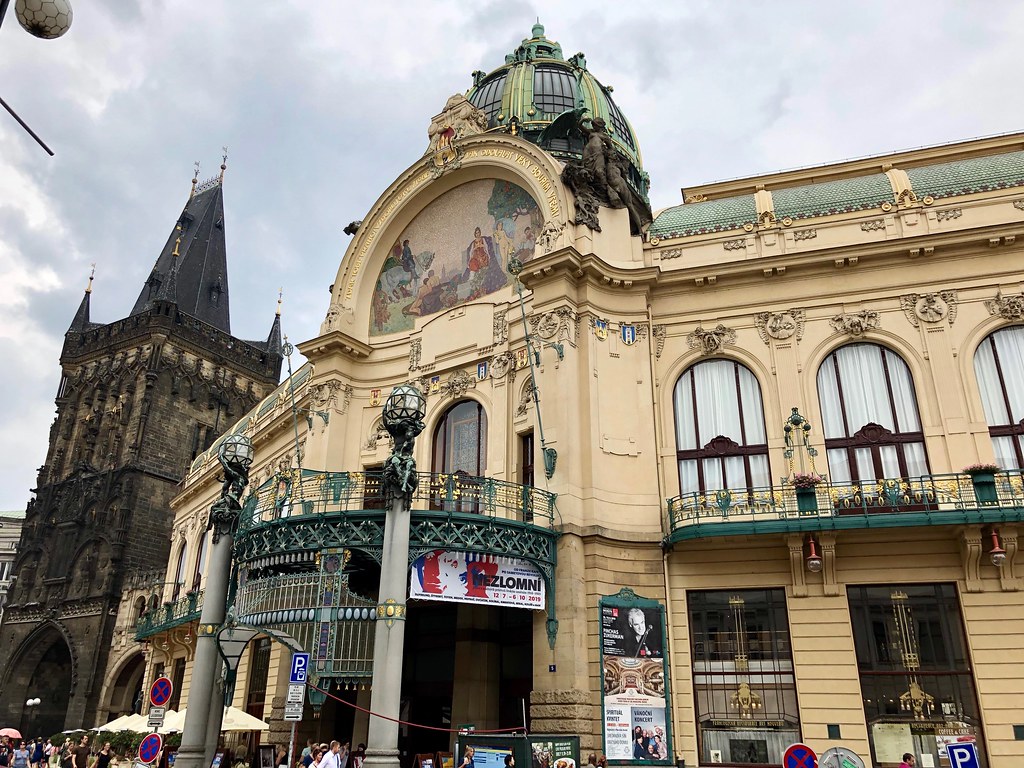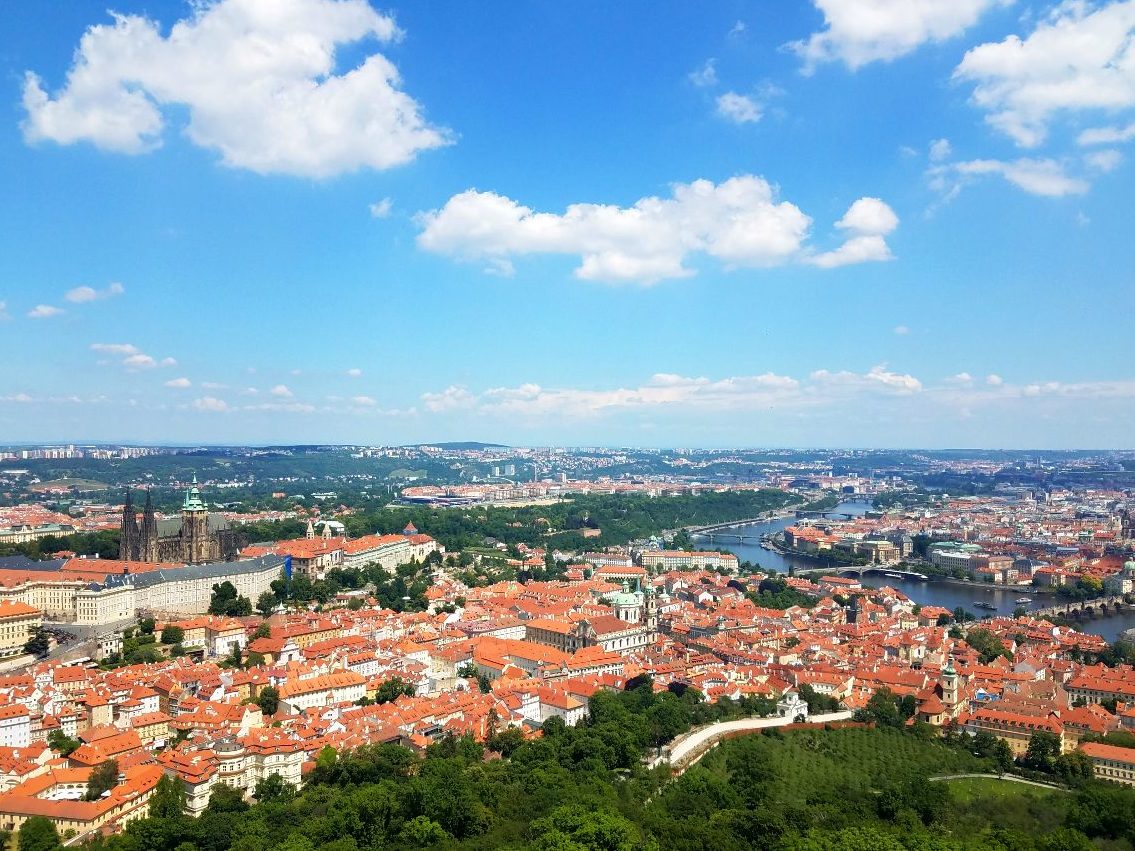Architecture of Prague, Czech Republic
Prague is one of the best-preserved cities in all of Europe. It miraculously survived the bombs of WWII that were prevalent throughout the continent, and much of its historic center looks the same way it did hundreds of years ago. Today Prague is the capital of the Czech Republic and is home to over 1.3 million people. Prague is also one of those rare examples of a city that contains buildings from every major age in architecture. Romanesque, Gothic, Renaissance, Baroque, and Rococo architecture can be found throughout the city. There are even spots within Prague, such as the Old Town Square, where you can see several different styles of architecture directly next to one another. Although the city is sometimes overlooked, Prague is one of Europe’s architectural highlights and is worth a visit for anyone looking to see some incredible buildings.
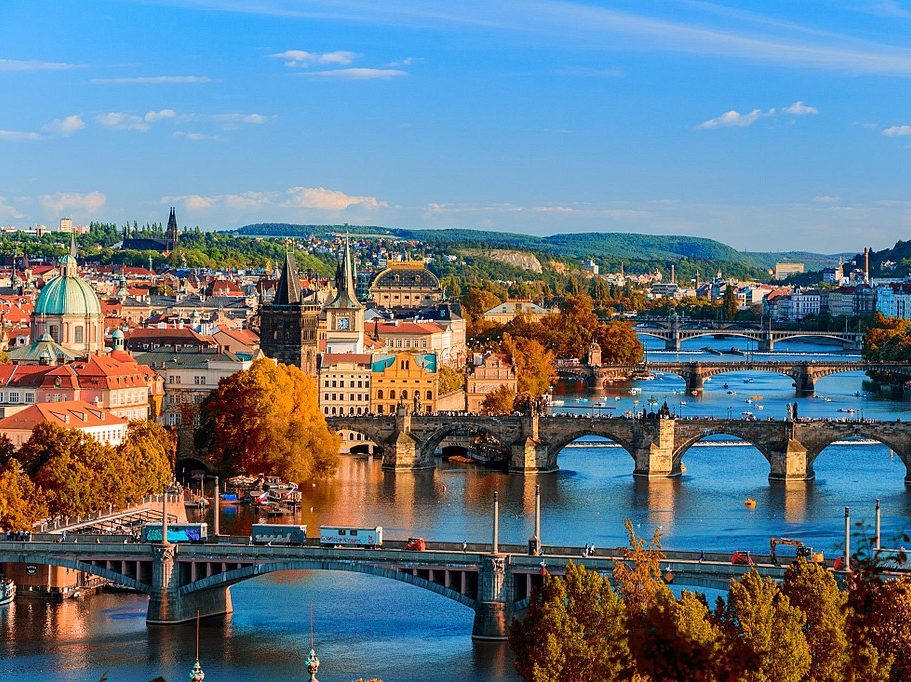
Map of Prague
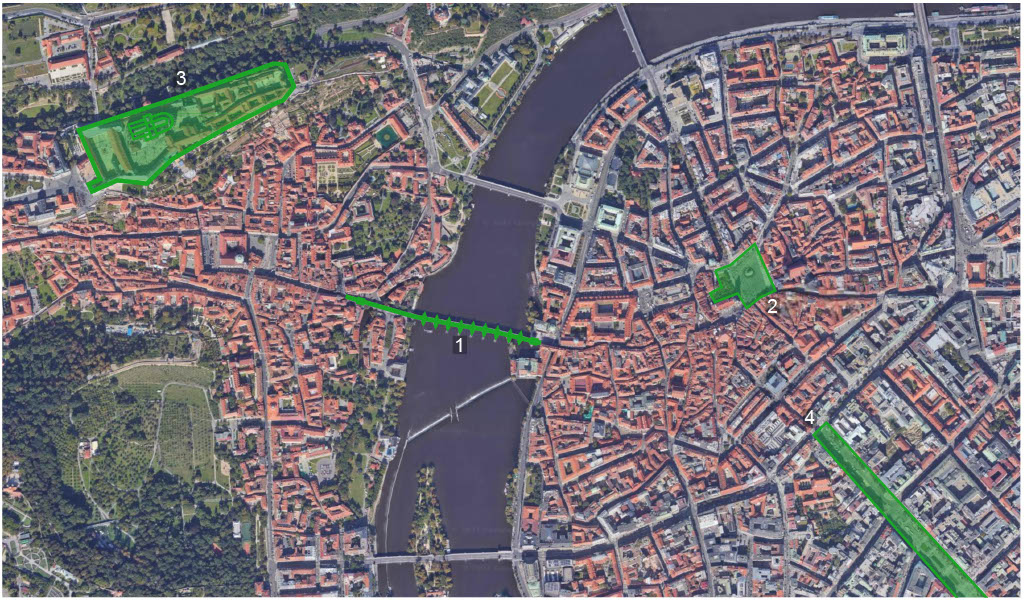
Map of Prague highlighting some of the city’s main attractions.
1. Outline of the Charles Bridge
2. Old Town Square
3. Prague Castle & St. Vitus Cathedral
4. Wenceslas Square
Table of Contents
History of Prague
Unifying Elements in Prague Architecture
Spires

Prague is often referred to as, “The City of One Hundred Spires” referring to the multitude of towers, steeples, and pinnacles throughout the city. This is in large part for functional reasons, since the annual snowfall in the city makes a pitched roof a necessity. But Prague in particular seems to have spires all over the place. The churches and monasteries, the bridges, the government buildings, and even the old medieval fortifications are built with spires and a great deal of vertical emphasis. You can really see it here in the symmetrical towers of the Church of Our Lady Before Tyn, where the two towers have a combined 18 pinnacles between them.
Influence of the Holy Roman Empire
Photo by Yannick Loriot from flickr

The Kingdom of Bohemia was a major player within the Holy Roman Empire for centuries. It served as an electorate and there were also a few Bohemian Kings that were elected emperors, such as Charles IV in 1355. The influence of the architecture of many other towns in modern-day Germany and Austria is apparent throughout Prague. Particularly in the oldest buildings of the historic center, there is a distinct German flare that resembles other towns – in fact, one can imagine how medieval Germany looked before the devastation of WWII just by looking at the architecture of Prague.
Czech National Revival
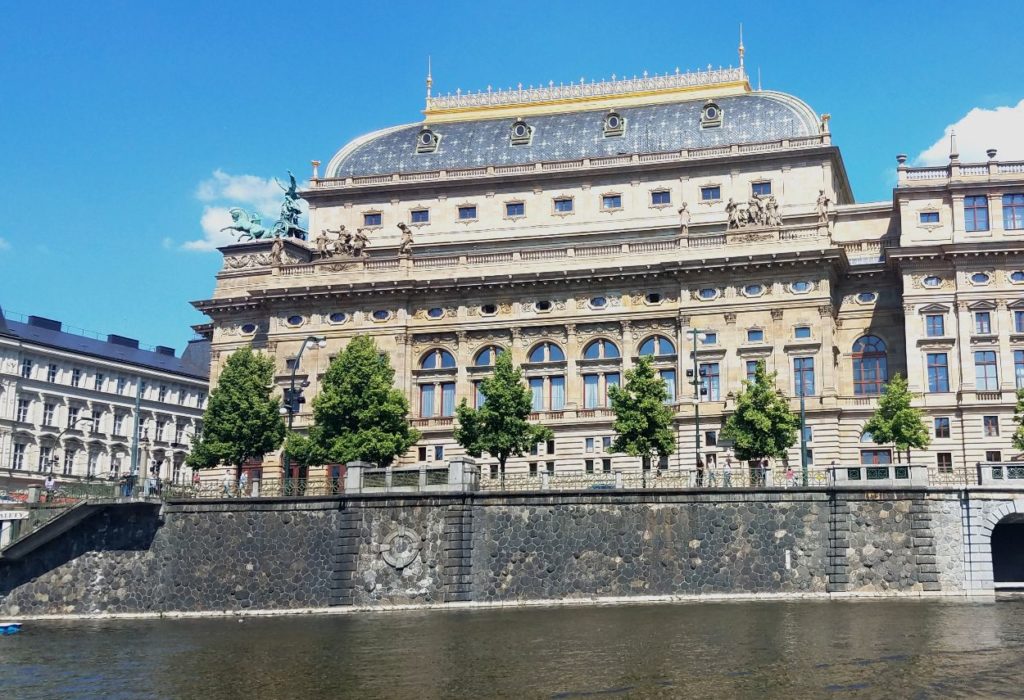
After centuries of Hapsburg Rule, the Czech people were struggling to maintain their own national identity. In the 19th century, a movement began that sought to bring back important characteristics of Czech Culture. Although this movement was primarily in language, art, and literature, the architecture of the nation was also affected. Buildings such as the Prague National Theater were a product of the movement. The builders of the theater wanted to create a space for performances in the Czech language, and they wanted to help create a space specifically for Czech-influenced performing arts. These same ideas are apparent elsewhere in the architecture of Prague. One of Prague’s largest squares was renamed Wenceslas Square in 1848 to honor St. Wenceslas, who was a Duke of Bohemia in the early 900s. A statue of the saint was added in 1912, which was done to reflect on Prague’s past as the capital of Bohemia.
Gothic Architecture in Prague
The Kingdom of Bohemia reached its cultural zenith during the Gothic Age. The reign of Charles IV from 1346–1378 marked the apex of the city’s importance. And it’s no surprise that Prague is filled with many incredible Gothic Buildings from this time period. Like in the rest of Europe, the Christian Community within the city helped finance massive churches, which was common during the Middle Ages. Prague stands out, however, for its abundance of non-religious Gothic Architecture. The Charles Bridge, the Old Town Hall, and Prague’s medieval fortifications are some of the city’s greatest secular Gothic Buildings. Even though all of these buildings are nestled amongst much more modern ones, you can still get a sense of the power of Prague at this time period from virtually anywhere in the city.

Map of Prague highlighting the most notable works of Gothic Architecture within the city.
The dashed line represents the outlines of Prague Castle and the medieval fortifications of the city.
1. Charles Bridge
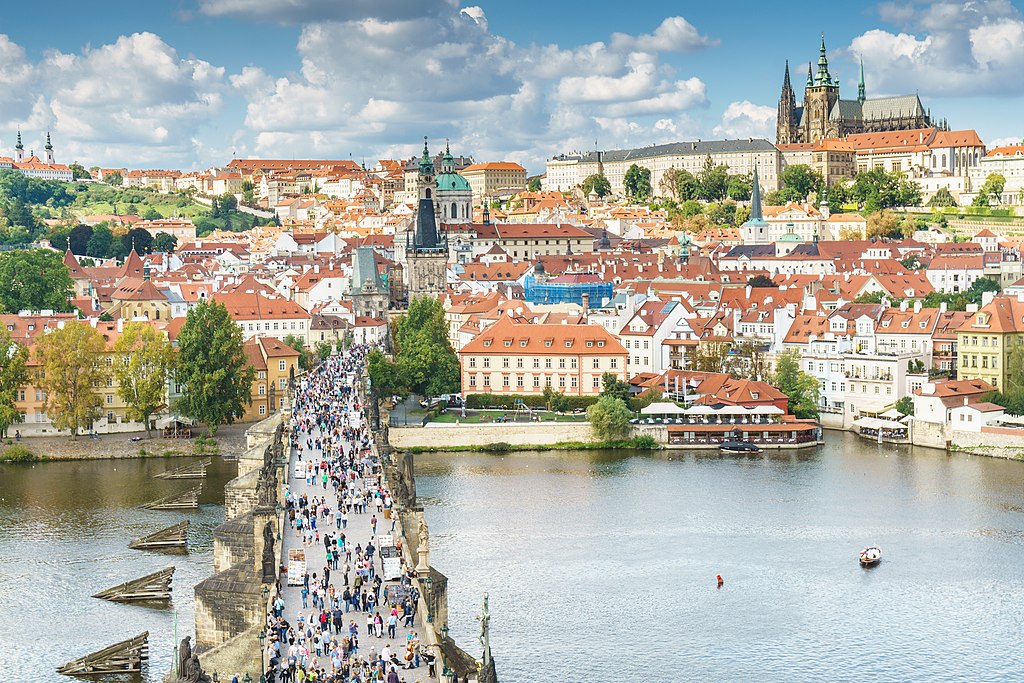
The Charles Bridge is one of the most popular attractions in Prague, and it’s one of the most famous bridges anywhere in Europe. [which is why we featured as #1 on our list of Top 12 Medieval Bridges] Construction began in 1357 during the Reign of Charles IV and continued for centuries as the bridge was altered and restored. A major rework was done in the Baroque Age when several statues were added along the walking surface. The towers located at either end were built with Gothic Architecture and were used to collect tolls from anyone crossing the bridge. The overall construction, like most bridges from this era, is made up of stone arches supporting a flat roadway.

Prague’s Old Town lies on the East side of the Vltava River and the neighborhood known as Lesser Town lies across the river. The Charles Bridge was built to better connect the two neighborhoods, replacing an older wooden bridge that would often be critically damaged during seasonal flooding. The bridge is also incredible because it miraculously survived all of the warfare that has plagued Europe. Bridges were naturally strategic targets, and many were destroyed not only in the two World Wars but also in other conflicts before and afterward. No visit to Prague is complete without a stroll down this historic bridge, and the views of the rest of the city are just as striking as the architecture of the bridge itself.
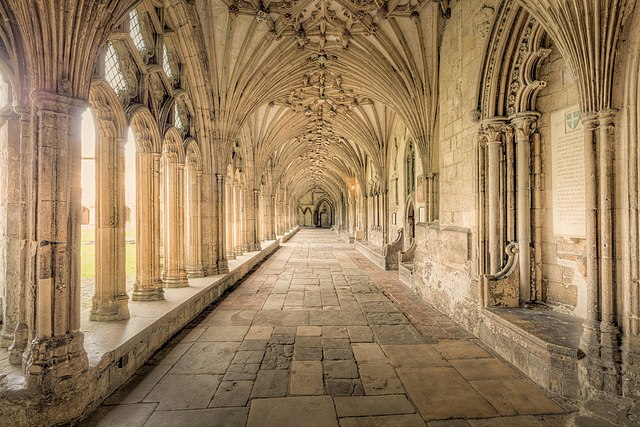
Gothic was the dominant architectural style in Europe during the early Middle Ages. Check out our article on the Top 25 Examples of Gothic Architecture to learn more!
2. St. Vitus Cathedral

Like so many other churches in Europe, St. Vitus Cathedral was a constant work in progress. It originated as a very early stone church in the 10th century, and in 1344, construction began on the Gothic portion. Work continued until it was halted in 1419 upon the breakout of the Hussite Wars. Renovations and additions took place again in the Baroque Age when the copper-clad spire of the South Tower was completed. This spire features several onion domes at the corners, which dramatically contrast with the Gothic Architecture in the rest of the building. It wasn’t until 1929 that the final elements of the church were completed, including some stained glass windows designed by the renowned Czech painter, Alphonse Mucha. These are a rare example of a 20th-century artist creating stained glass in such an old building.

St. Vitus Cathedral was built within the walls of Prague Castle, which has served as the city’s main citadel since the 9th century. Because the church sits atop Prague Castle Hill, it is the highest point in the entire city and it can be seen from just about anywhere. Thousands of people visit the church every year and the entire Prague Castle Complex is listed as part of a UNESCO World Heritage Site along with several other notable works of architecture within Prague. Today St. Vitus Cathedral remains an icon of the city, and it has helped Prague earn the nickname, “The City of 100 Spires.”
3. Prague Astronomical Clock
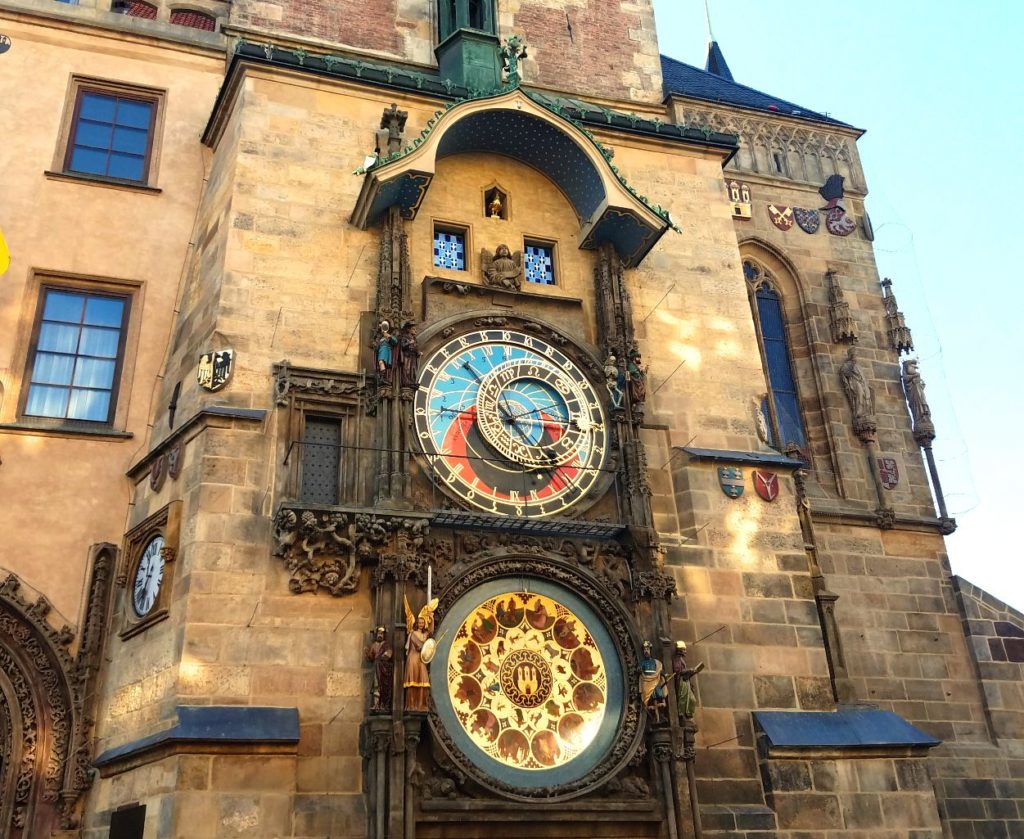
Prague Astronomical Clock was first installed in the early 15th century, overlooking the Old Town Square in the middle of Prague. The clock face provides the time, in addition to many other things including the sunrise, sunset, and the phases of the moon. The clock is attached to the tower of the Old Town Hall, and every hour there is a sequence of bells and moving figures to mark the end of the hour. Although the clock face is centuries older, many of the statues and details around the clock were added in the Baroque Age. Today in modern Prague, huge crowds gather every hour on the hour to enjoy the spectacle of the Prague Astronomical Clock.
4. Church of Our Lady Before Týn
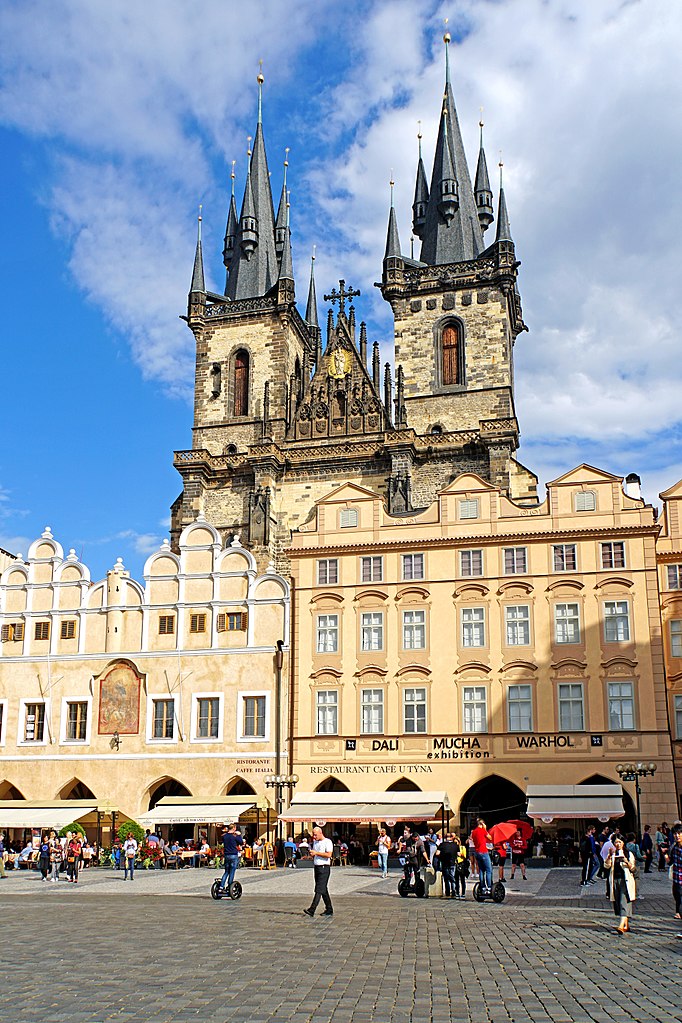

One of the most iconic works of Gothic Architecture in all of Prague is the Church of Our Lady Before Týn. It was built in the 14th century, replacing an older Romanesque Church from the 11th century. The stained glass windows are tall and narrow, and they were built with vertical emphasis, which was common in the late Gothic Era. The Church of Our Lady Before Týn was the central church of the Hussites for over two centuries. The Hussites were a branch of Christianity that opposed the Roman Catholics in Italy. War broke out between the Hussites and the Holy Roman Empire after the execution of Jan Hus, the founder of the movement.
5. Old Town Square
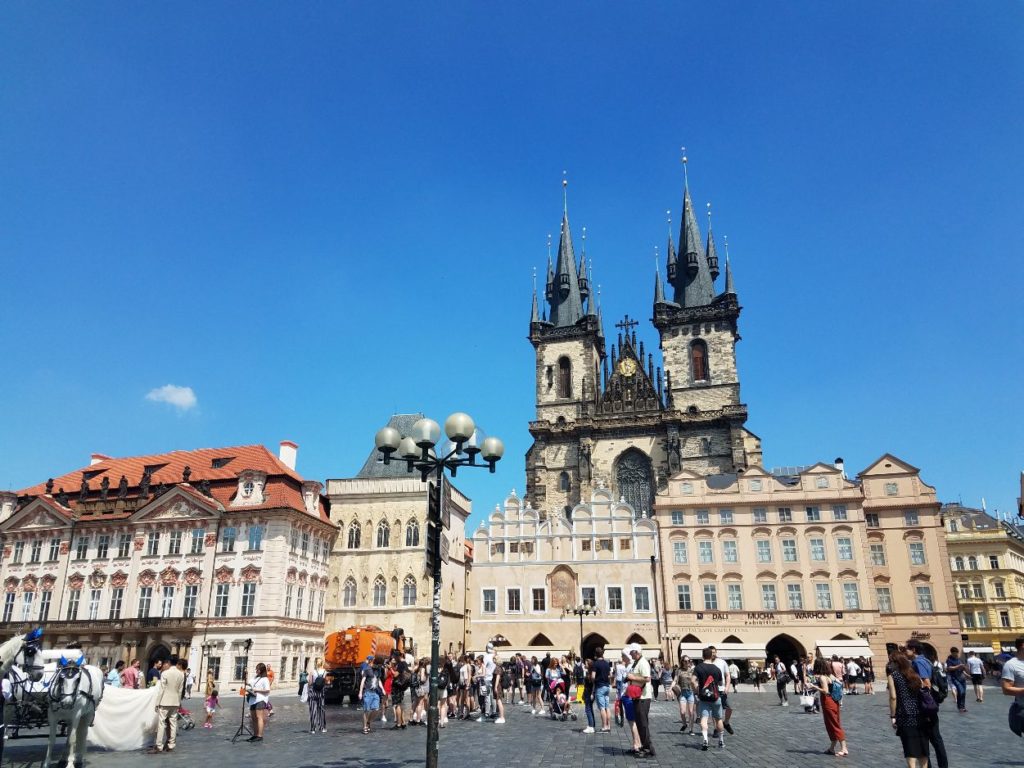
Located in the heart of Prague’s Old Town, is the aptly named Old Town Square. The foundations of the square date back to the initial days of Prague itself, when the city was a small regional capital within the Holy Roman Empire. Over the centuries, dozens of different buildings were constructed along the perimeter of the square including the Old Town Hall, Kinský Palace, and the Church of Our Lady Before Týn. The square is one of the most lively spots in Prague, and it’s a popular spot for restaurants and nightlife. It’s also one of the few places in Europe where you can clearly see buildings from several different ages of architecture, all in one location.
6. Vladislav Hall of Prague Castle

Vladislav Hall was built within Prague Castle as a space for royal banquets by King Vladislaus II. Construction began in 1493, and eventually, the hall became one of the largest open spaces within Prague Castle. The vaulted ceilings are by far the most striking feature of the space. The organic curvature of the vaulting is a distinctive element of Late Gothic design. These vaults were an engineering challenge for the time, and the unique geometry of the vaulted ceilings still amazes modern-day visitors.
7. Fortifications of Prague


(right) Charles Bridge Tower – Photo by Erik Cooper from flickr
Prague built one of the most impressive examples of Medieval Fortifications anywhere in Europe. Prague Castle stood atop a hill across the Vltava River, and the Vyšehrad Fortress was located on the banks of the Vltava just south of the city center. The two forts were connected by a system of walls that also surrounded Prague’s historic center. These walls featured some intricately decorated Gothic towers. Like a lot of other cities in Europe, Prague chose to dismantle the majority of its defensive walls in an effort to prevent overcrowding and improve traffic flow. Luckily, several of the walls’ most impressive towers were preserved
8. Old Town Hall
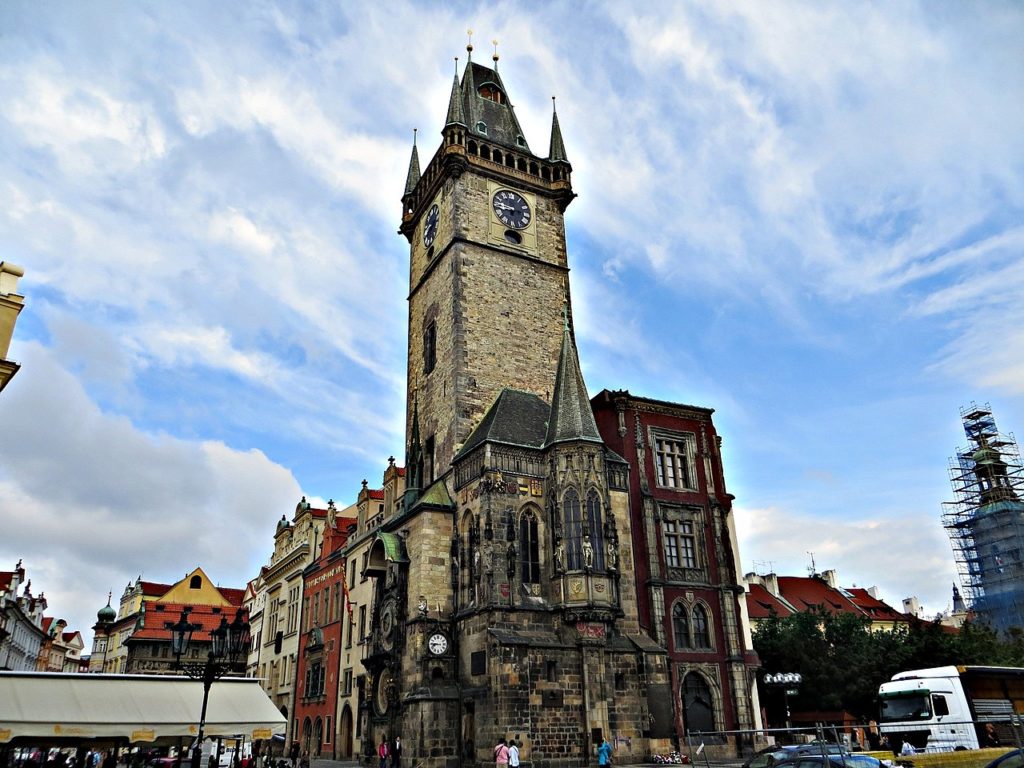
Prague’s Old Town Hall was built in the 14th century and is another great example of Gothic Architecture within the city. The tower and the adjacent chapel were all completed in the first Gothic phase of the building, and then several other additions were completed in subsequent centuries. The city council chambers were originally located within the building, but have since been moved to a larger, more modern structure. The Old Town Hall is very recognizable since it is so close to other important sites within the city. Prague Astronomical Clock is attached to the exterior of the Town Hall, and both monuments are located within the Old Town Square.
9. St. George’s Basilica (Interior)

There are several churches and chapels located within the walls of Prague Castle, of these, St. Vitus Cathedral is by far the most iconic, but St. George’s Basilica is a close second. It is the oldest church within the castle, being founded in the year 920 CE. The interior of the church is primarily in the Romanesque Style, and the nave has thick and heavy stone walls with small windows. But like Prague Castle itself, St. George’s Basilica was continuously modified over time, and its present form contains elements of Romanesque, Gothic, Renaissance, and Baroque Architecture. Although it can sometimes be overlooked, no visit to Prague Castle is truly complete without a visit to St. George’s Basilica.
10. Old-New Synagogue

The Old-New Synagogue is one of the oldest Gothic Buildings in the entire city of Prague. Its construction dates to 1270, when it was a place of worship for Prague’s large Jewish Community. The synagogue is located in an area known as Josefov, also called the Jewish Quarter. Josefov is regarded as one of the most culturally significant neighborhoods in the entire city. It contains several Jewish Cemeteries, Synagogues, and the Jewish Museum in Prague.
11. Church of Our Lady in the Snows


The Church of Our Lady of the Snows is a Gothic-Style church within Prague’s historic center. The church was founded in 1347 to commemorate the coronation of King Charles IV. It has one of the tallest church naves in the entire city, and despite its small footprint, it is an imposing building when viewed from the exterior. The Church of Our Lady of the Snows was intended to be much larger than what we see today, but the Hussite Wars of the early 1400s put a stop to construction. Only part of the nave was completed, along with a great bell tower, which collapsed in the 17th century.
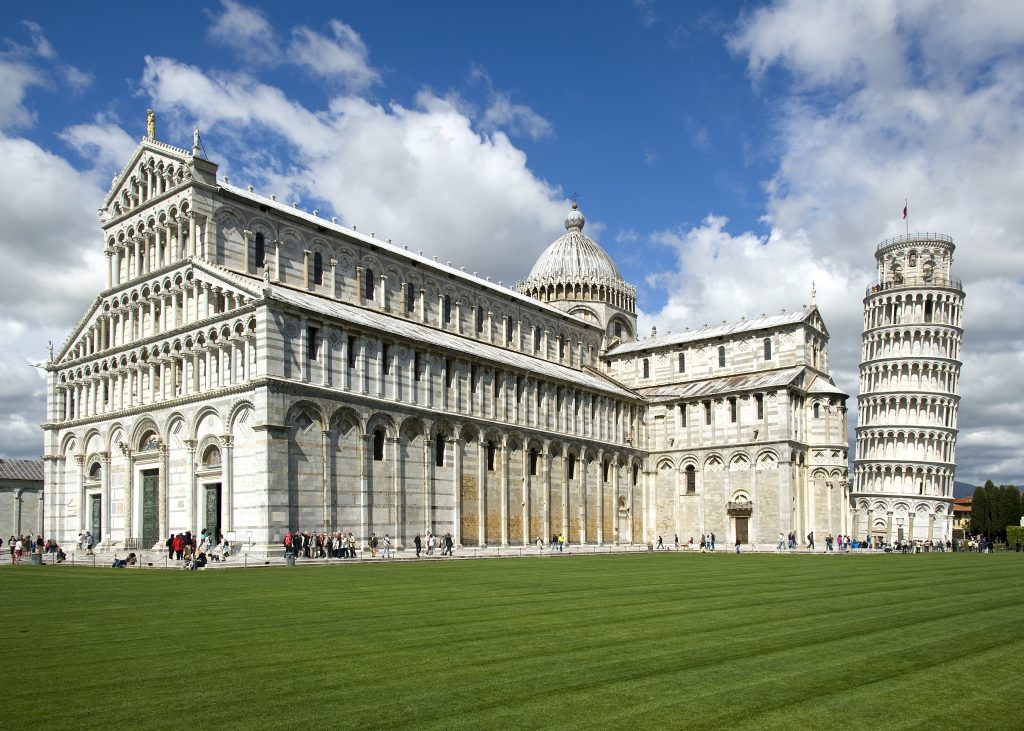
Romanesque was Europe’s dominant architectural style from the 10th-11th century. Read our article, “Romanesque Architecture and the Top 15 Romanesque Buildings” to learn more!
12. Church of St. Martin in the Wall

Hidden down a lesser-known street in Prague’s city center is the Church of St. Martin in the Wall. It was built starting in 1178, and there was a major Gothic Restoration completed in the mid-1300s. It originally stood right next to the medieval walls of Prague, which is how the church gets its name. The church is typically free from the crowds that frequent most of Prague’s other sites. It’s a great example of the many hidden gems located within Prague, and only travelers who stray from Prague’s busier streets will find unknown historic buildings like this.
Renaissance & Baroque Architecture in Prague
Prague remained the leading city in Bohemia throughout the 16th-18th centuries, at which point in time it expanded outward from the historic center. New Neighborhoods were being populated such as Nové Město or the New Town, and a new modern fortification network was built surrounding the city. Although the Kingdom of Bohemia would be ruled by the Austrian Hapsburgs from 1526–1918, Prague was still able to maintain its influence. As a result, many important works of architecture from the Hapsburg era can be found throughout the city. The Humanist Movement and the Renaissance had a huge influence, and several prominent buildings were made in the Renaissance Style. Prague also saw a building boom in the Baroque Age. During this time huge palaces were being built in and around Prague Castle, while highly ornamental Baroque Churches were being built throughout the rest of the city.

Map of Prague highlighting the most notable works of Renaissance and Baroque Architecture within the city.
The outlines of the Baroque Age fortifications are shown with a dashed line.
1. St. Nicholaus Church (Malá Strana)
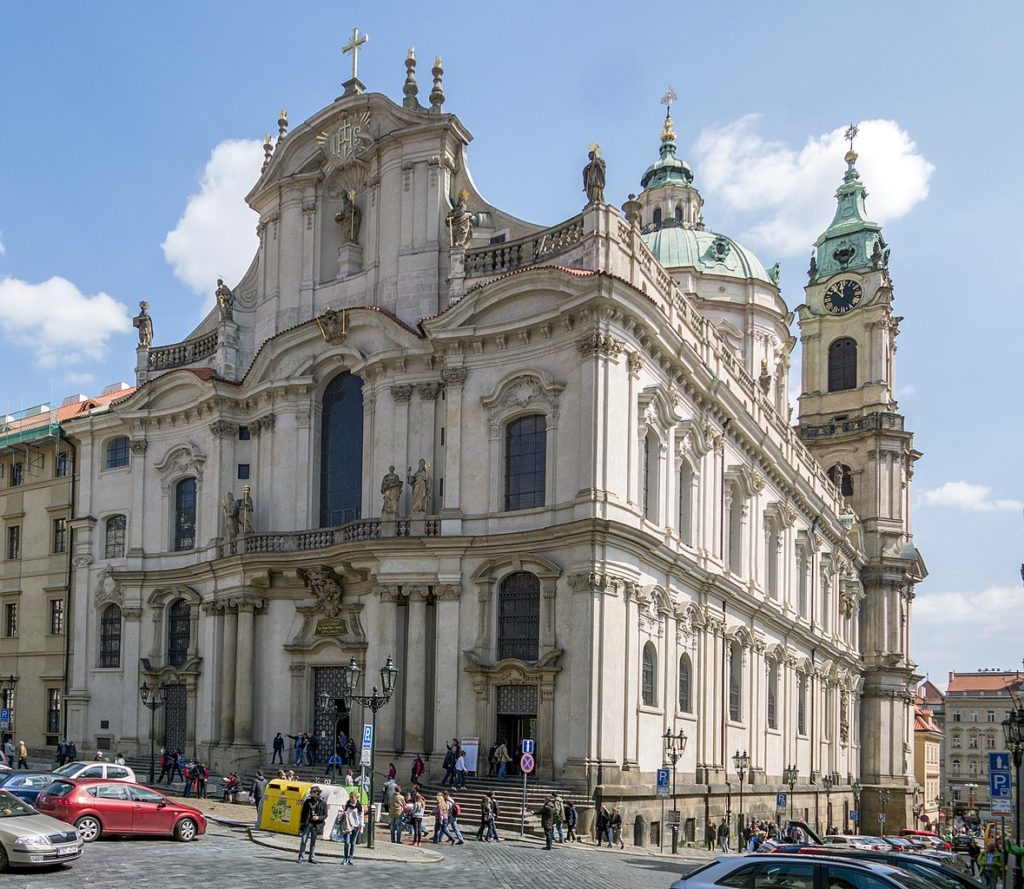
St. Nicholaus Church, located in the Malá Strana neighborhood of Prague, is one of two different churches in the city named for St. Nicholaus. Construction began on the current church in the year 1704, and it replaced a much older Gothic Church. The entire building took 51 years to complete, and it was done completely in one harmonious style. Because of this, it is often regarded as the most important work of Baroque Architecture anywhere in Prague. The exterior of the church shows several typical Baroque elements such as the undulating curvature of the front facade.
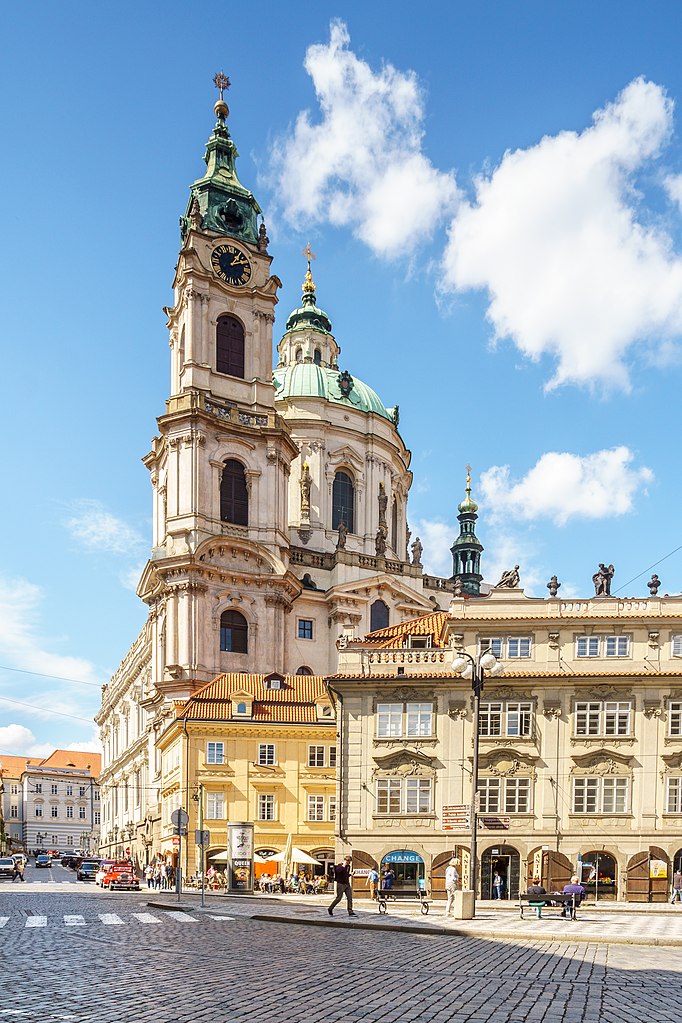
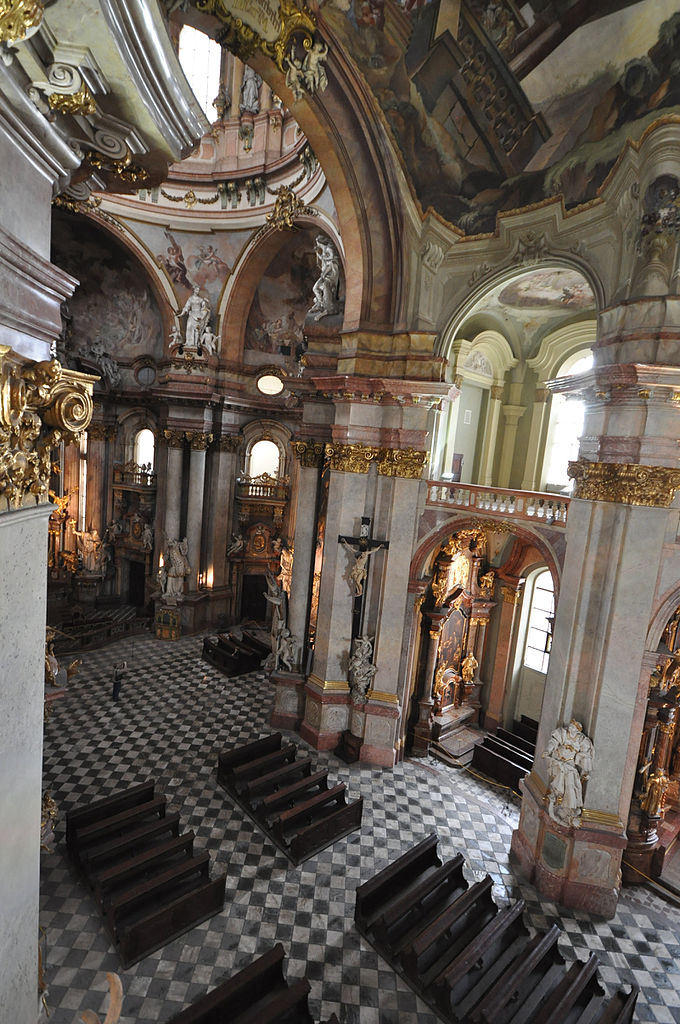
The dome and the bell tower both stand high above the surrounding neighborhood, and they can be seen from all over the city. Inside the church, there is a plethora of Baroque paintings and statues. Several frescoes are painted on the interior ceilings of the church, and these frescoes are meant to look like the sky, drawing the occupant’s gaze upward. Just about every interior surface within St. Nicholaus Church is coated with faux marble. The use of faux or painted marble was common in buildings during the Renaissance and Baroque ages, and it gives the effect of lavishness and grandeur while also being cost-effective.
2. Wallenstein Palace & Gardens
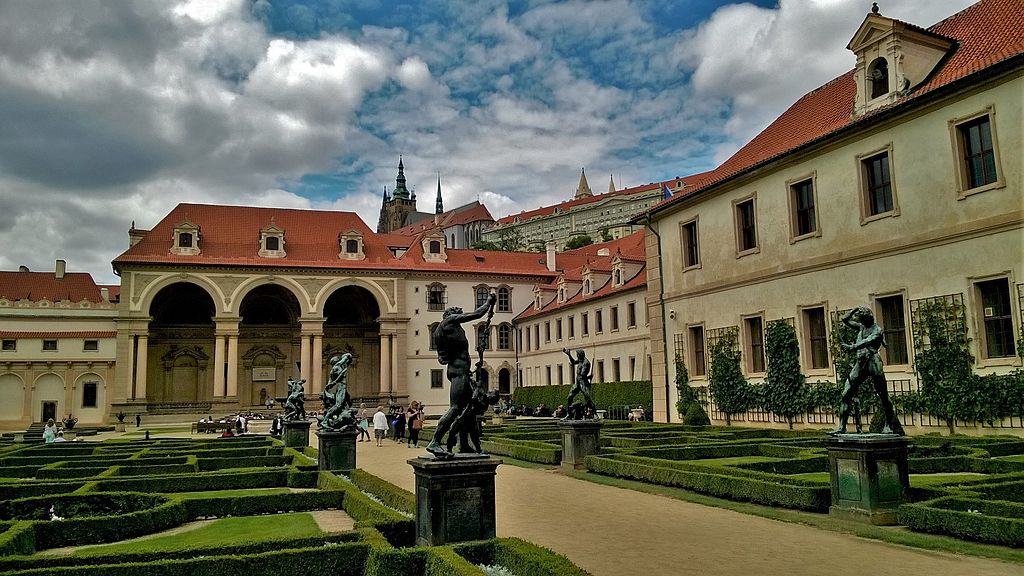
Now housing the Senate of the Czech Republic, Wallenstein Palace was once a Baroque Palace owned by a wealthy government official. The Palace is located beneath Prague Castle and is only a short walk to the Vltava River. It contains an elaborate series of gardens, many of which are filled with water features, hedges, and classical statues. Construction began on the palace in the year 1623 and lasted until 1630.

Inside Wallenstein Palace, you will find ornately decorated rooms with all of the typical Baroque Elements like luxurious materials, intricate moldings, and lively painted frescoes. There were extensive renovations and modifications done to the interior in the 21st century, as a way to modernize the building and improve its functionality for the Czech Senate. Today the palace gardens are open and easily accessible to the public. Visitors can admire the precisely manicured shrubs and lawns, which are quiet and secluded when compared to the busy city outside.
3. St. Nicholaus Church (Old Town)

Not to be confused with the other St. Nicholas Cathedral in the Malá Strana neighborhood, the St. Nicholas Church in Prague’s Old Town is a Baroque Building dating from 1732. It’s located on the edge of Old Town Square, one of Prague’s most popular hang-out spots. Just like a few other churches in Prague, it was built in a relatively short period and is cohesively designed in a unified Baroque Style. When the Austrian Hapsburgs ruled over the Kingdom of Bohemia, they built a lot of Baroque Buildings in an effort to show the prosperity of their empire. So much of the architecture of Prague as well as the rest of the Czech Republic was commissioned by the Hapsburg Kings and Queens.
4. Statues of the Charles Bridge
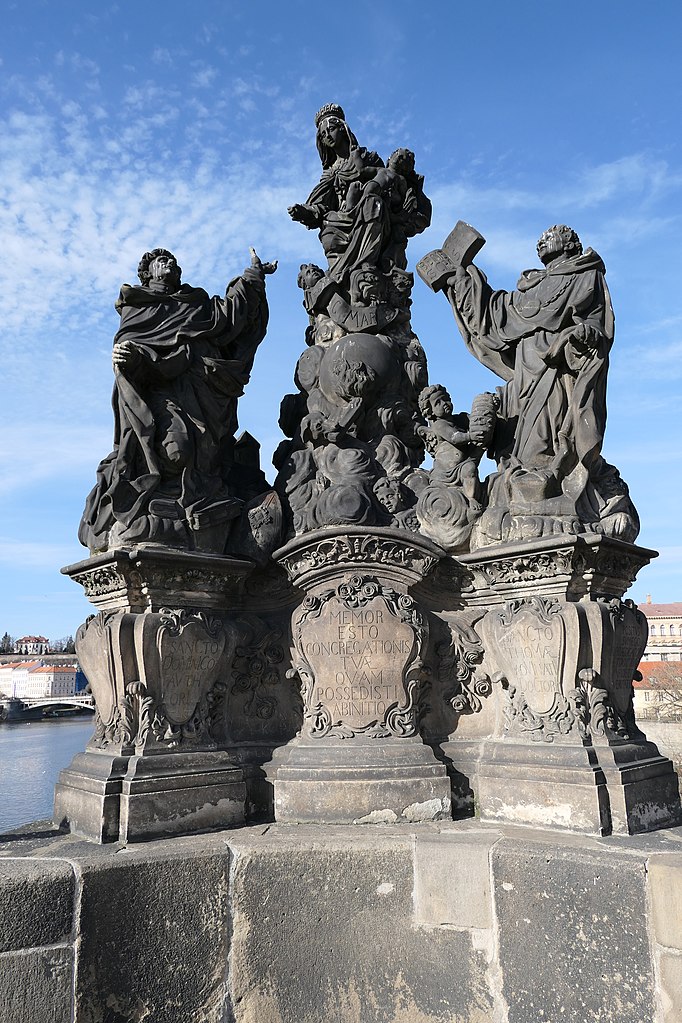

Although the Charles Bridge is one of the most incredible Gothic Sites in the city, several of the bridge’s decorative elements date to the Baroque Age. There are 30 Baroque Statues in total, which line the 1,700-foot (518 M) long roadway on top of the bridge. All of these statues were installed in the early 1700s, and they depict various religious scenes. They are great examples of Baroque Sculpture, which has a fluidity and sense of motion much like Baroque Architecture. The statues seem as if they belong on the bridge, even though they were installed centuries after it was completed. This combination of Gothic and Baroque architecture is one of the many reasons why the Charles Bridge is one of the most iconic sites in Prague.
5. Palaces of Prague Castle
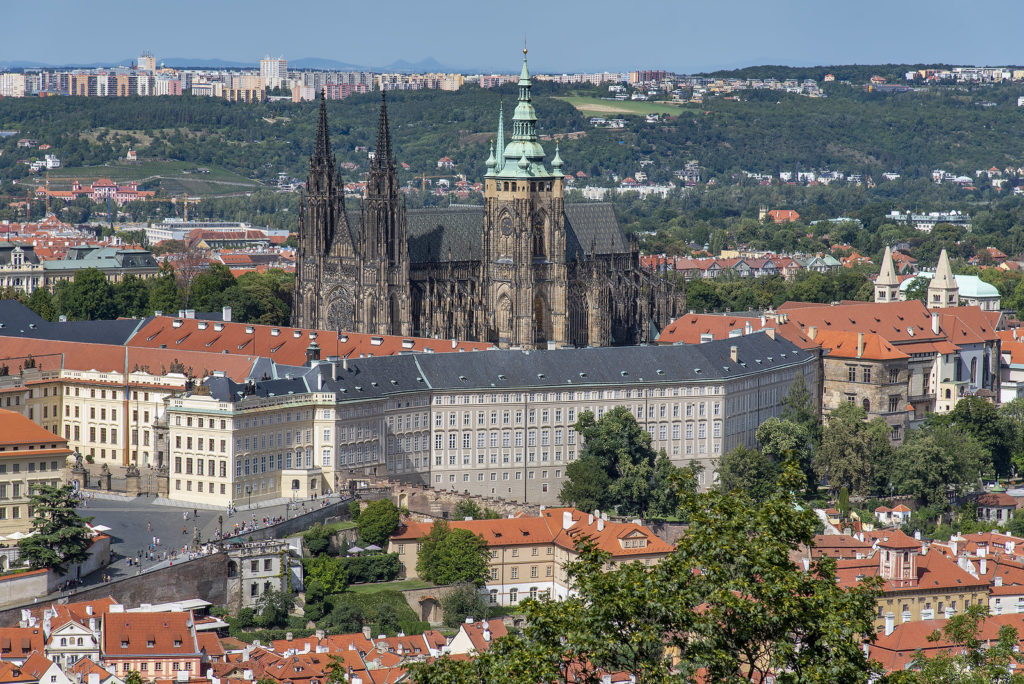
Just like in the rest of the city, you can find buildings from all of Europe’s main architectural movements within Prague Castle. In addition to Romanesque and Gothic Churches, there are a few Renaissance and Baroque Palaces located within the castle complex. The Hapsburgs King Rudolf II financed a massive addition to the castle and created the incredible Spanish Hall in the 16th century. Hapsburg Empress Maria Theresa commissioned a massive renovation project in the 18th century which added an extensive Baroque wing to the southern side of the castle complex.
6. Church of St. Francis of Assis

Known for its iconic green dome, the Church of St. Francis of Assisi is one of two Baroque churches located at the entrance to the Charles Bridge on the East side of the Vltava River. The dome of the church is veneered with copper, which has a bright green patina. The cylindrical drum beneath the dome is painted bright pink and white, and together, those colors and the green dome are a bright spot in Prague’s busy skyline. Although the exterior isn’t as decorative as other Baroque churches in the city, the interior of the Church of St. Francis is covered with all of the intense detailing that is typically seen in Baroque Architecture.
7. Strahov Monastery

The Strahov Monastery was founded back in 1143 when Bohemia was just a Duchy and not a full kingdom. It was the home to many monks and the Czech rulers of Prague were often great patrons of the monastery. The Theological Hall (depicted above) was completed in 1679. It was considered a higher institute of learning in its day and many people regard this as the most beautiful space in the entire Strahov Monastery Complex. Many of the “prohibited books” – which were texts seen as forbidden by the Christian Church – were kept in a locked box within the library. They were only available to a select few, during a time when knowledge wasn’t as easily accessible as it is today.
8. Loreta Praha
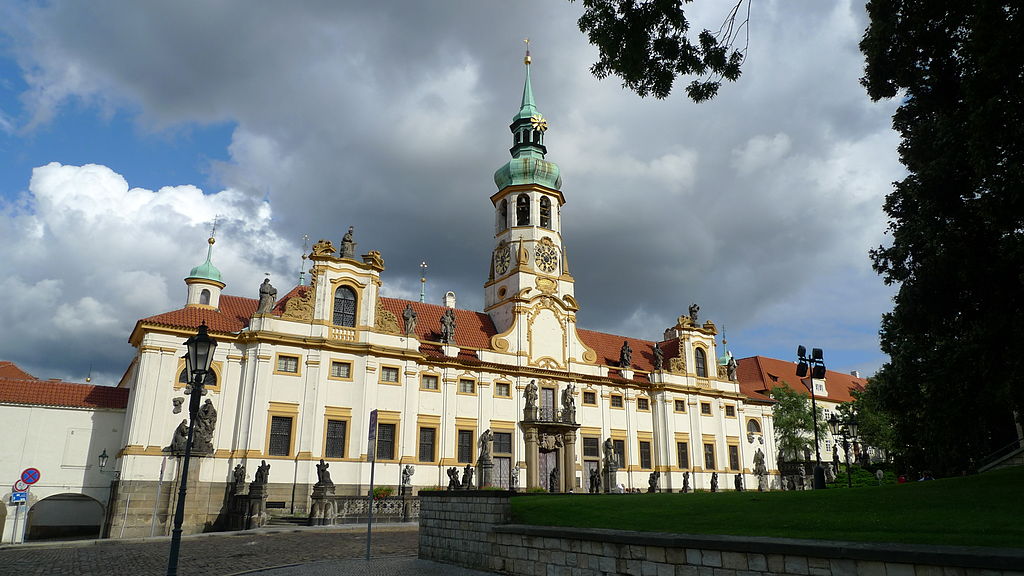
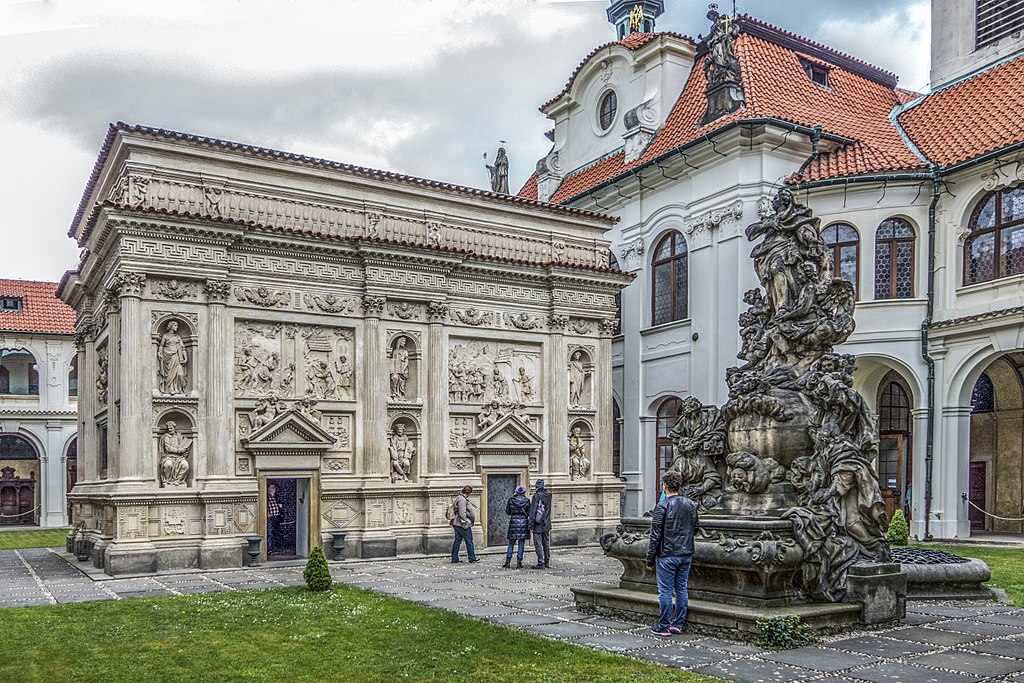
(right) Photo by Jerzy Strzelecki from Wikimedia Commons
Located in the neighborhood of Hradčany, a district of Prague surrounding Prague Castle, the Loreta is one of the city’s most important religious buildings. The Loreta is a Baroque building that was constructed beginning in 1626. The clock tower at the center of the church is one of its most iconic elements. Located within the church are several impressive monuments. Inside there is an exact replica of the Santa Casa that’s located in Loreto Italy. The Santa Casa is a monument containing several religious artifacts supposedly belonging to the apostles. The artifacts are enshrined within a large marble screen that was designed by Donato Bramante during the Renaissance Age. The four facades of Bramante’s design are meant to copy all of the basic elements of Ancient Roman Architecture. They resemble several of the Triumphal Arches that the Romans were so fond of building.
9. Church of St. Salvator

The Church of St. Salvator is located right next to the Church of St. Francis of Assisi in Prague’s Old Town. It was built as part of the Clementinum, a cluster of buildings dating back to the 16th Century. Parts of the interior of the church are older and are in the Gothic Style, but the church saw a major Baroque update in the 1650s. These Baroque renovations were done in the early stages of the movement and you can see the transition from the Renaissance to a more playful, decorative, and luxurious form of architecture. The facade of this church greatly resembles that of the Basilica of Santa Maria Novella in Florence. The proportions and the geometry are similar, but here in Prague, you can see the elegance of the Baroque that was so widely utilized in the 17th and 18th centuries.
10. Church of St. James

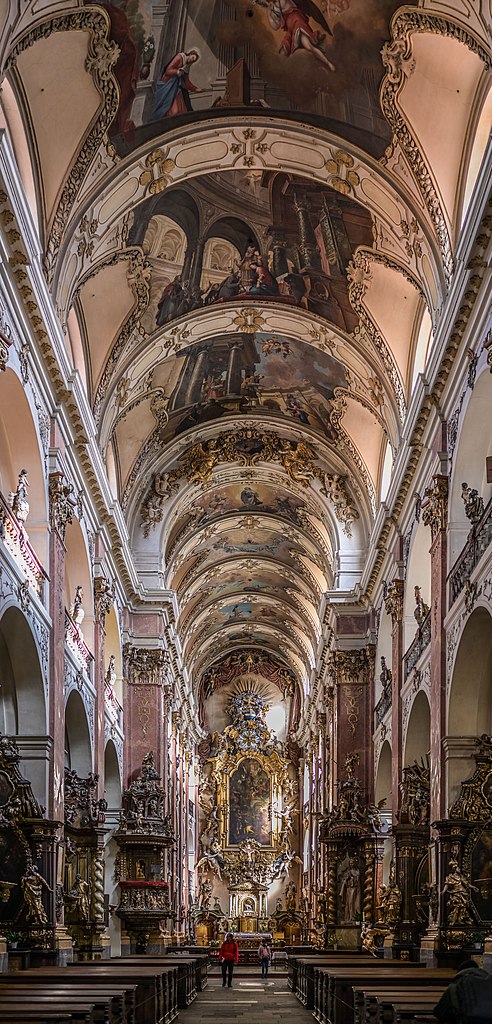
(right) Photo by Bengt Nyman from Wikimedia Commons
Much like several of the other churches in Prague, the Church of St. James originated as a Gothic-Style building. It stood for over 300 years from the 13th century until 1689 when it burned down in a devastating fire. Immediately after this, the church was rebuilt in a new and more contemporary style, Baroque. The Church of St. James might be one of the more opulent churches in all of Prague. The front facade features massive stone sculptures around the windows. Each one is a flurry of human figures surrounded by clouds and other objects. The interior is covered with intense detailing, particularly in the vaulted ceiling which features multiple frescoes painted between the arches.
11. Cernin Palace

Cernin Palace is one of several Baroque Palaces in Prague built by high-ranking officials within the Hapsubrug Empire. It was built in the mid-17th century, and although the exterior is more modest than other Baroque Buildings on this list, Cernin Palace is still one of the most impressive buildings in the city thanks to its scale. The building is massive, with a front facade measuring nearly 450′ (137 m) long. There are also two large courtyards separated by additional wings stretching another 130′ (40 m) deep behind the facade. Today Cernin Palace houses the Czech Foreign Ministry which has resided there since 1930.
12. Vyšehrad

The Vyšehrad is part of Prague’s extensive fortifications. The castle was built on the site in the 11th century, two centuries after Prague Castle was founded. It’s located just south of the historic center of Prague, along the banks of the Vltava River. The Vyšehrad helped secure the city from the south and helped control traffic up and down the Vltava. Because of its strategic importance, the fort was given major upgrades in the Baroque Age. Since the adaptation of gunpowder, the Vyšehrad was considered obsolete, so short thick walls and bastions were added, in a typical Star Fort layout. The fort was then incorporated into a large Baroque Age wall that surrounded both the Old Town and the Lesser Town of Prague.
13. Archbishop’s Palace

Originally located in a different location, the Archbishop’s Palace was moved directly across from the main entrance to Prague Castle during the year 1561. The building was heavily modified and expanded during the late 1500s, and work was done in the Renaissance Style. However, many of the new archbishops who moved in and out of the palace over the years wanted to make changes. Beginning in 1676, a massive Baroque renovation began. These changes completely altered the front of the building, creating the edifice that still exists today.

Interested in Renaissance Architecture? Check out our article on the Architecture of Florence to learn more about the birth of the Renaissance Movement.
14. Saints Cyril and Methodius Cathedral
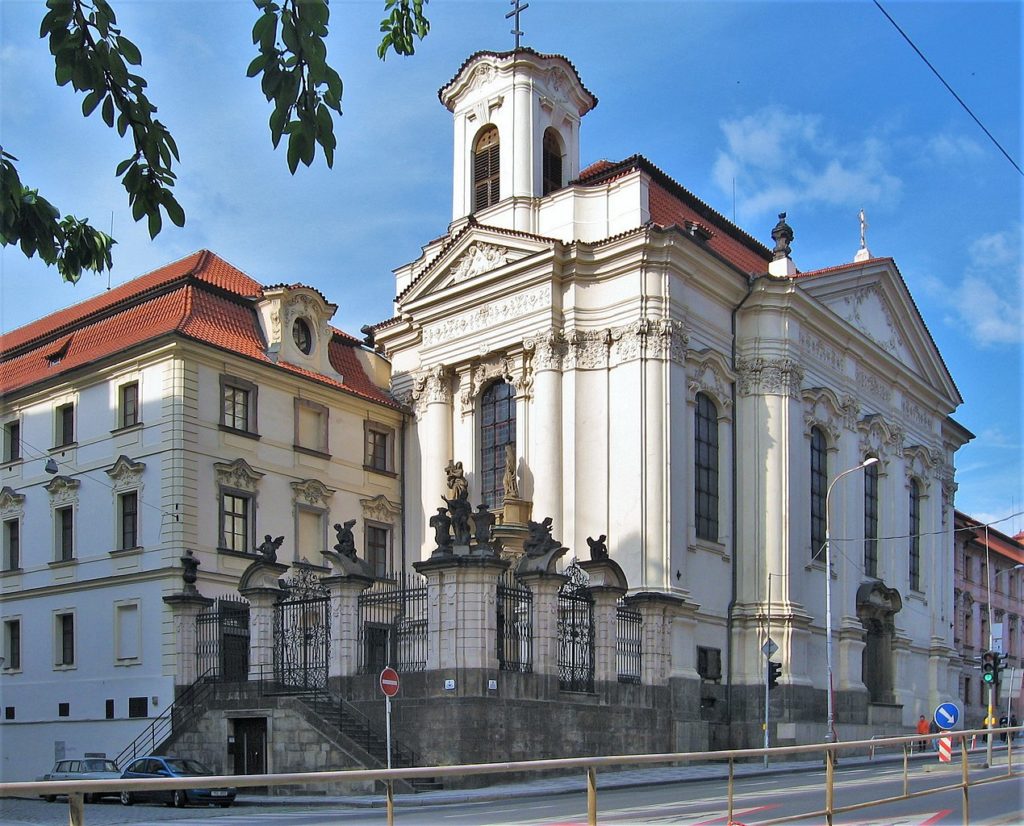
Prague’s New Town is an area filled with Art Nouveau and Revival Architecture from the 19th and early 20th centuries. But nestled amongst the busy streets of the modernized New Town, you can still find historic works of architecture from the Baroque Age. Saints Cyril and Methodius Cathedral is one example of this. It was built in the early 18th century, during the later stages of the Baroque Movement. The church contains a small memorial and museum dedicated to the men who died in Operation Anthropoid. This was a covert military operation led by a combined team of members from the Czechoslovak Army and a British intelligence group to assassinate a prominent member of the Nazi Army during WWII. The operation was a success, but several of the Czechoslovak Army officers were killed, Their last stand against the enclosing Nazi Troops was at the cathedral.
15. Schwarzenberg Palace

Schwarzenberg Palace is an early Renaissance building located in Prague’s Castle District. The palace is richly decorated with floral and geometric patterns painted throughout the exterior. It was built starting in the year 1545, shortly after the Renaissance spread out of Italy. Schwarzenberg Palace was built by the prominent House of Schwarzenberg, a noble house that owned dozens of castles throughout modern-day Austria, Germany, and the Czech Republic. Although the city is known for its Baroque buildings, the Renaissance Architecture of Prague is still some of the most striking in all of central Europe.
16. The Clementinum and National Library

The Clementinum is a group of buildings located in Prague’s historic center. The various buildings within the complex date from a 700-year span from the 11th to the 18th centuries. The Clementinum has housed the National Library of the Czech Republic since the Baroque Age when it was founded in 1777. The library here rivals Prague’s Other major Baroque Library at the Strahov Monastery. Here the incredible frescoed ceiling is a distinct Baroque Element within the space. The Solomonic Columns at the sides of the room were also widely utilized in the late Renaissance and Baroque Ages.
17. Kinský Palace
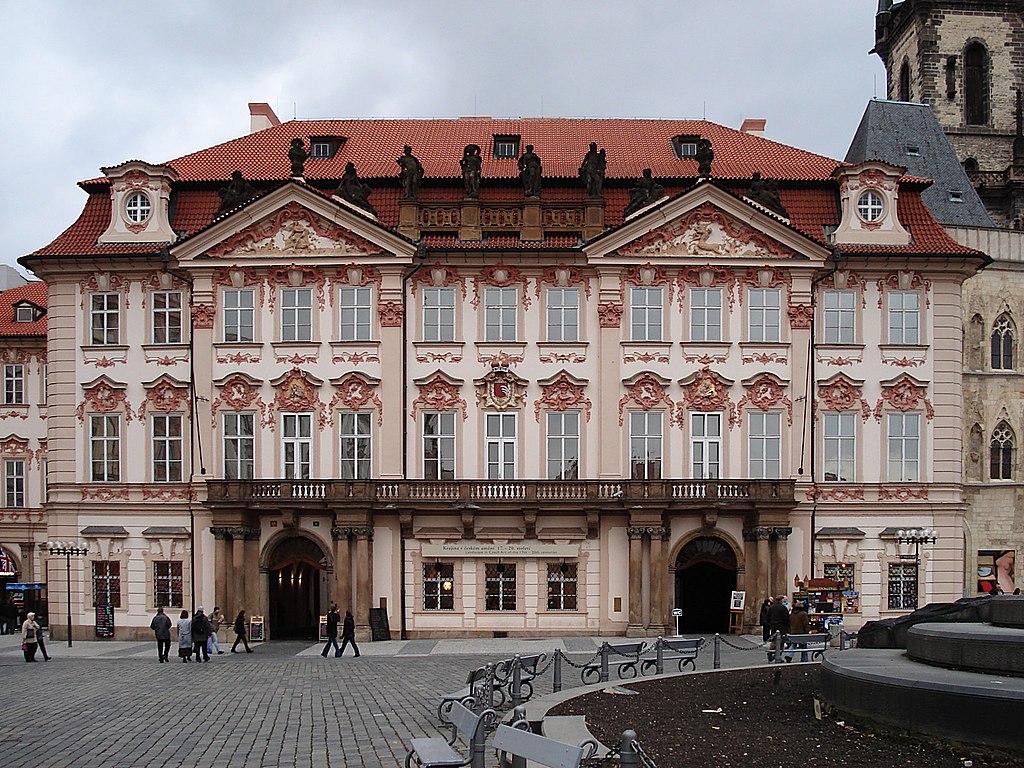
Although today it houses a popular Art Museum, the Kinský Palace was built by a wealthy local family to be their private residence. The palace is built on the edge of the Old Town Square in the center of Prague. Construction began on the building in 1755 and lasted for about 10 years. The front facade that faces the square is decorated with pink pastel-colored detailing, with flowery floral trim around the windows. This use of various shades of pink was another key element within the Baroque Style that was very popular in Prague. The colors of Kinský Palace help contribute to the Old Town Square’s complexity and it’s one of its most notable landmarks.
18. The Estates Theater

The Estates Theater originally opened in the year 1783. It was built along the southeastern edge of Prague’s historic center, right next to where the Medieval Wall of the city once existed. Over the centuries the name of the theater changed several times, but it has been continuously running as a public theater since opening at the end of the Baroque Age. Today the theater hosts a variety of different events focusing on Ballet, Opera, and Dramatic Theater.
Like Architecture of Cities? Sign up for our mailing list to get updates on our latest articles and other information related to Architectural History.
Revival Architecture in Prague
Prague saw a dramatic transformation in the 19th century. Like in the rest of Europe, the Industrial Revolution led to a building boom, particularly in the second half of the century. This was the era of Revival Architecture, and styles like Neoclassical, Gothic Revival, and Renaissance Revival were the dominant styles of the day. At this point in time, Prague also saw the evolution of the Czech Nationalist Movement. The Czech people grew tired of Hapsburg Rule and the dominance of the Austro-Hungarian Empire, and they sought to preserve their culture and national identity. This movement was prevalent in several different forms of art including, painting, literature, and architecture.
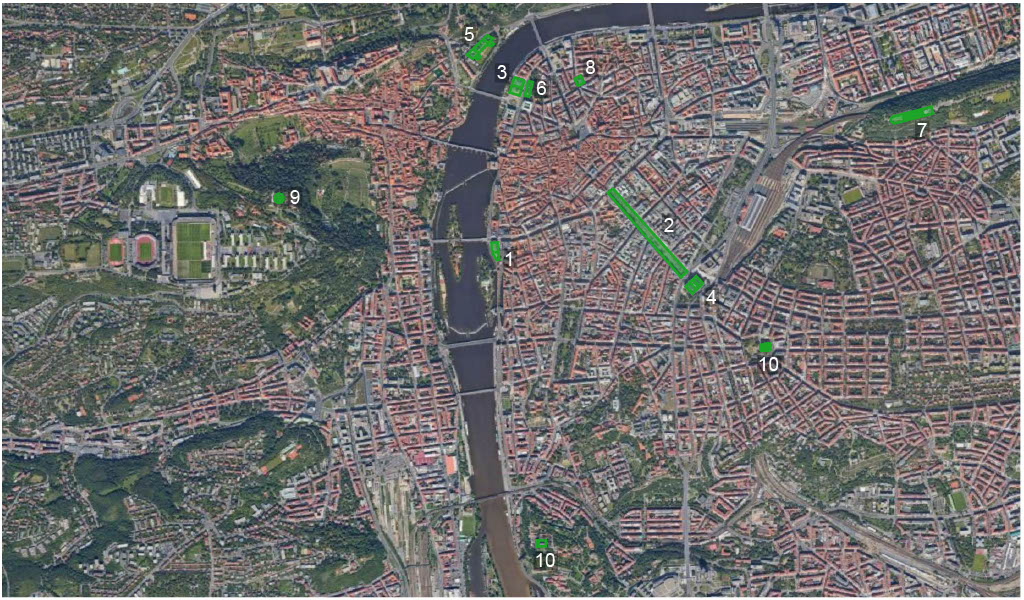
Map of Prague highlighting the most notable works of Revival Architecture within the city.
1. Prague National Theater

The Prague National Theater sits at the edge of the Vltava River Bank, right in the heart of Prague’s New Town. It was completed in 1881, after a lengthy process of proposals and approvals that led to its construction. The people who financed the building wanted to create a space to celebrate Czech theater and art. This was a key theme in the Czech Nationalist Movement which was gaining steam in the second half of the 19th century. The theater holds various ballet, opera, and drama events every year and both tourists and locals frequently visit shows. But even if you don’t make it inside for a performance, you can still enjoy the spirit of the building from the exterior.
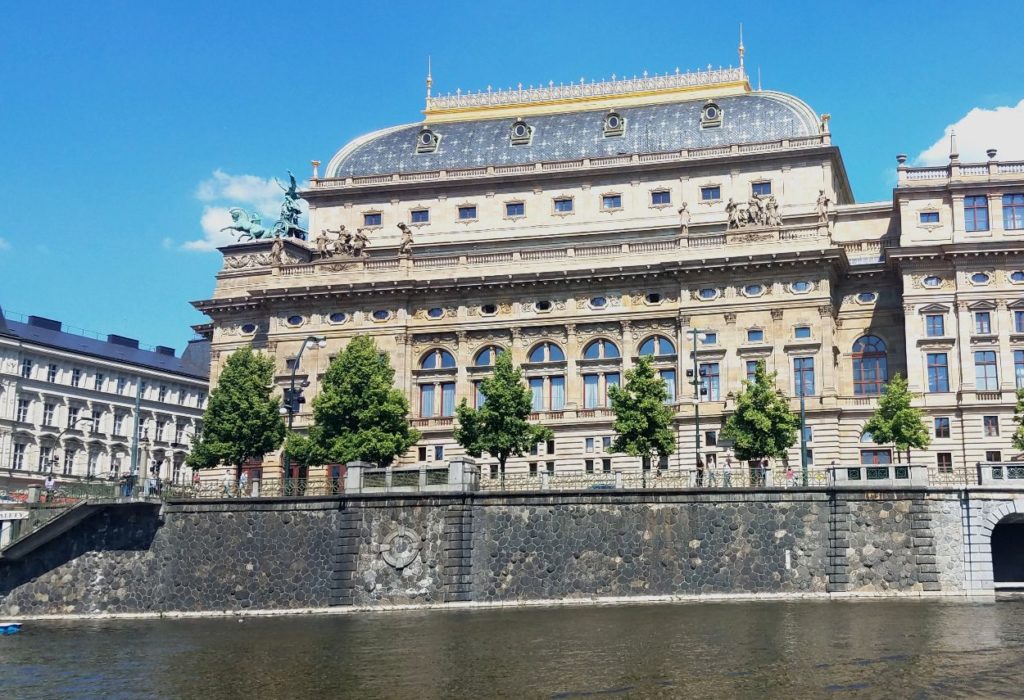
The Prague National Theater is designed in a Neo-Renaissance Style. It was built at a time when Revival Architecture was popular throughout the world. The exterior of the building is covered with details from classical architecture, which was a theme back in the Renaissance Movement. There are Corinthian Capitals atop the columns, pediments, and round arches around the doors and windows, as well as statues within niches and on top of the roof balustrade. The splendor of the age is apparent in the rich materials in the building, such as the intricate stonework, the gold plating, and the bronze statues.
2. Wenceslas Square
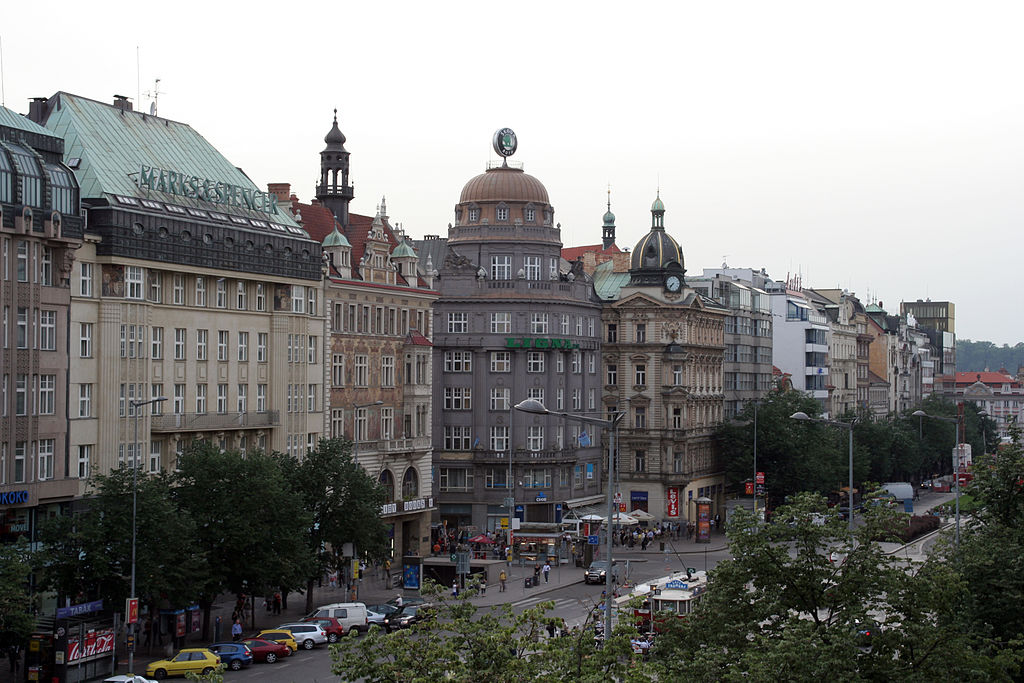
Wenceslaus I reigned as Duke of Bohemia from 921-935. He was extremely wealthy and his reputation was known throughout central and western Europe. He was the first notable Duke of Bohemia to bring great fame and recognition to the city of Prague, and after his death, he was canonized as a saint. Because of his reputation, many buildings and landmarks within Prague are named after him. Wenceslaus Square is one of the best examples of this. The square is the largest in Central Prague, and it is located within the New Town Neighborhood. Located at the center of the square is a giant statue of Wenceslaus I. Many Prague locals use the statue as a meeting spot before a night out.
3. Rudolfinum
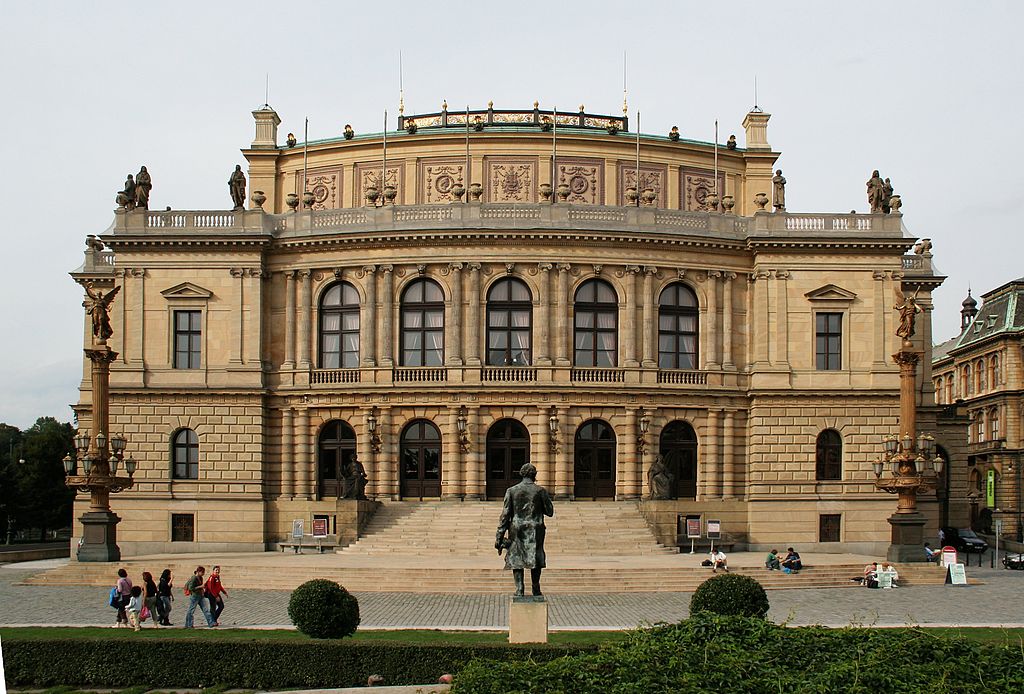
The Rudolfinum is another great example of Revival Architecture within Prague. It is built in a Neo-Renaissance Style, borrowing most of its characteristics from the original Renaissance. It opened its doors in 1885 and has been a renowned music auditorium ever since. The Czech Philharmonic Orchestra plays regularly within the Rudolfinum, and the space also holds other events and concerts. The front facade of the building faces a busy road that connects with Manes Bridge, one of several bridges over the Vltava River.
4. National Museum
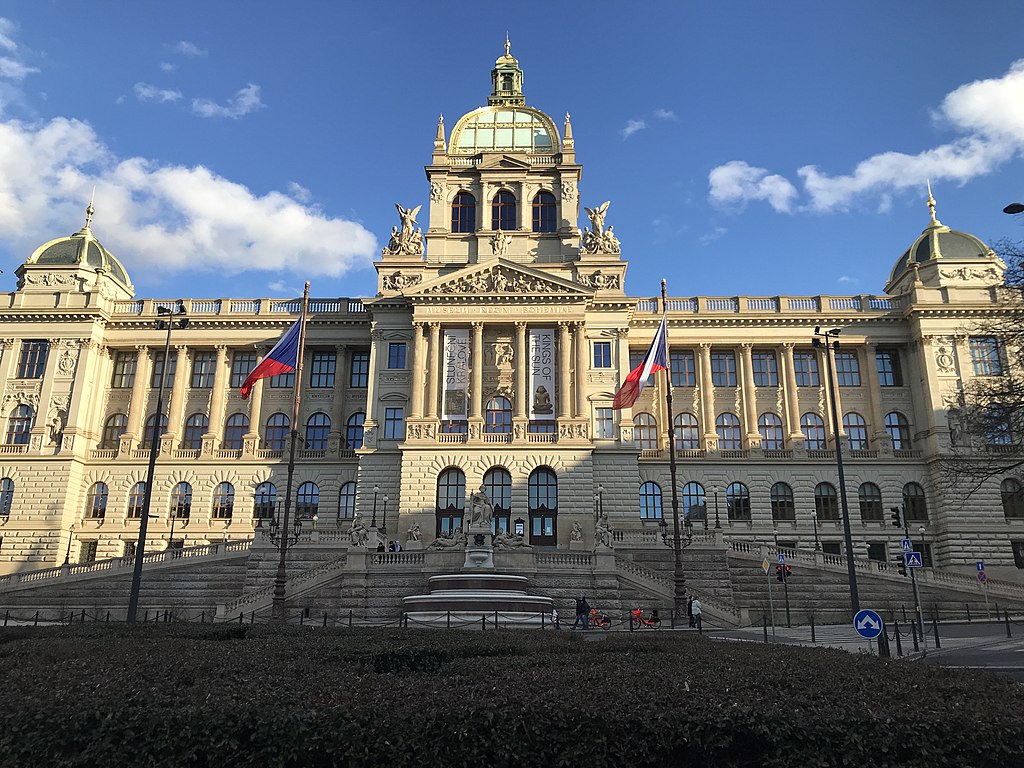
Another Neo-Renaissance building in Prague is the National Museum. Originally established in the early 19th century, the museum houses artifacts related to the city of Prague and the Kingdom of Bohemia. The collection grew significantly for decades, thanks partly to the renewed interest in Czech arts and culture brought on by the Czech Nationalist Movement. The museum collection grew to the point that a new building was constructed to house the artifacts. The new building was built at the far end of Wenceslaus Square, in a location overlooking the entire area. It was completed in 1891, just in time for the General Land Centennial Exhibition which took place that year.
5. Straka Academy
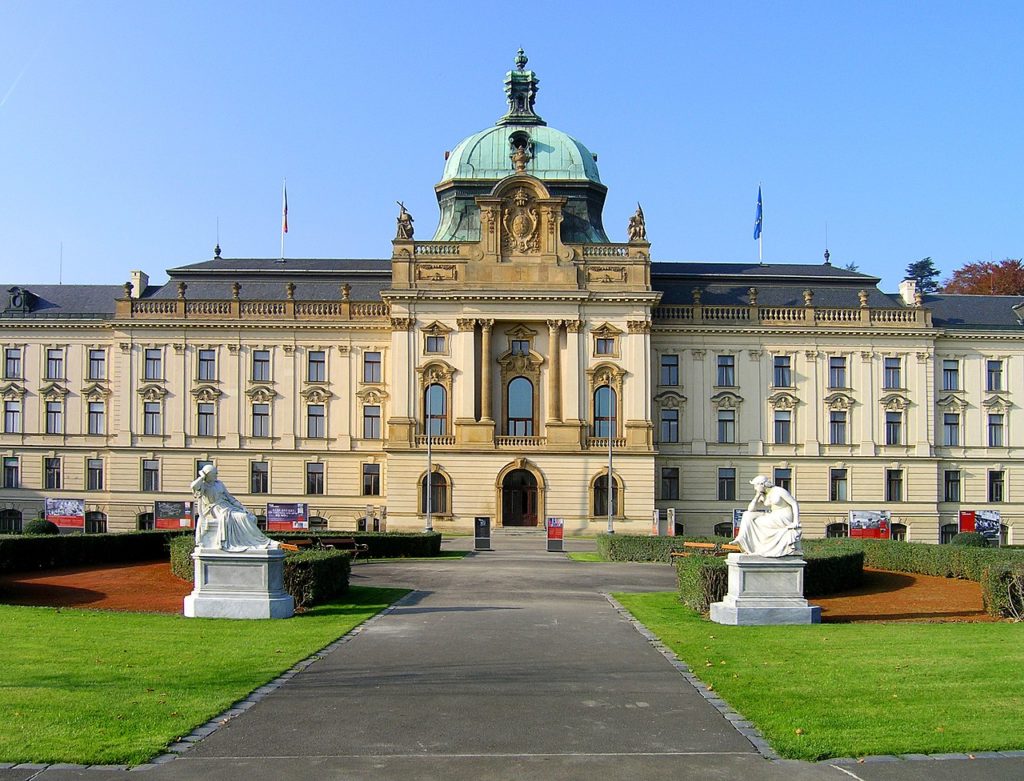
The Straka Academy Building is another late 19th-century building that was built in one of the Revival styles. The Neo-Baroque building currently houses the Government of the Czech Republic. It sits on the north bank of the Vltava River, across from Prague’s Old Town. It was completed in 1896 and the builders borrowed many of the features from other Baroque Buildings that were located in the surrounding area. As a result, the Straka Academy resembles some of the large palaces located just beneath Prague Castle. In addition to its intricate Baroque Revival Exterior, the building is also impressive because of its scale, it has a total length of over 650 feet (198 m).
6. Museum of Decorative Arts
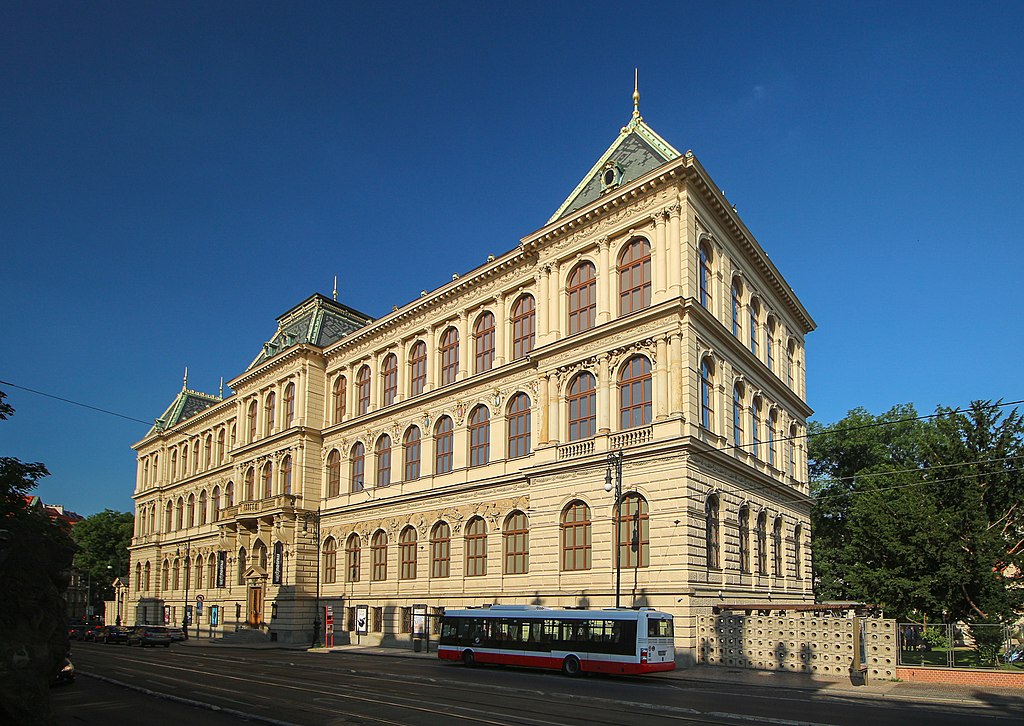
Completed in 1899, the Museum of Decorative Arts is another impressive building located right across the street from the Rudolfinum. Its symmetrical and rhythmic facade is a great example of the Renaissance Revival Style. The museum was built during a time of transition for Prague. The local Czech population was growing tired of rule from the Austro-Hungarian Empire. It wasn’t long after the completion of the Museum of Decorative Arts that Prague became the capital of the newly formed Czechoslovak Republic in 1918 after the end of WWI.
7. National Memorial on Vítkov Hill

The National Memorial is built atop Vitkov Hill to commemorate an important battle that occurred on the same spot back in the year 1420. The battle took place between an army of Hussite Soldiers who were fighting for their Hussite faith against the Catholic forces of the Holy Roman Empire. It ended with a victory for the Bohemians and the event came to be known as the Battle of Vitkov Hill. The memorial features one of the world’s largest Bronze Equestrian Statues. The Tomb of the Unknown Soldier can also be found within the memorial, which is meant to commemorate all soldiers who fought for the Czech People.
8. Spanish Synagogue

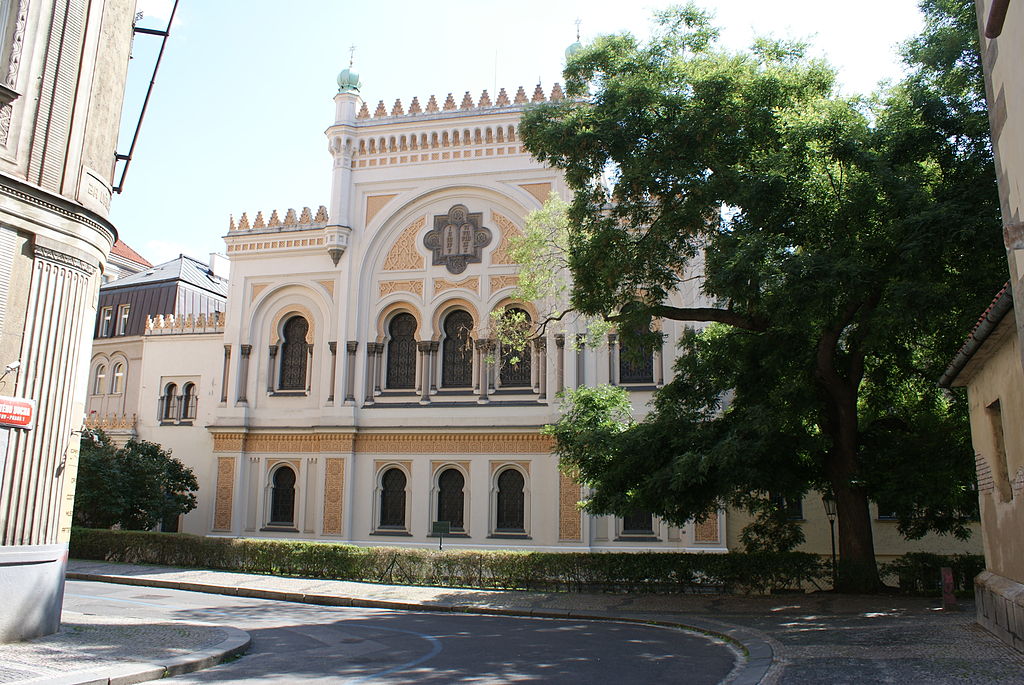
Built in the 1860s, Prague’s Spanish Synagogue is a testament to the long-standing Jewish Community living within the city. The Synagogue was built in the Moorish Revival Style, which was popular during the 19th century. It sits atop the location of Prague’s oldest Jewish Synagogue, which is part of why the modern building is so significant. The Moorish Revival Style is present both inside and outside. The exterior features horseshoe arches and the interior is covered with intricate geometric patterns, which were common throughout Moorish Architecture.
9. Petřín Tower

Petřín Tower is another monument that was completed for the General Land Centennial Exhibition, which took place in Prague in 1891. It no doubt was inspired by the infamous Eifel Tower located in Paris. The Eifel Tower was completed just two years prior in 1889 to commemorate a World’s Fair that took place that year. Petřín Tower is located at the top of Petřín Hill, and it, therefore, has commanding views of the entire city. Visitors have been climbing the building’s spiral staircase every day since the monument opened back in 1891.
10. St. Peter and Paul’s Basilica and Church of Saint Ludmila

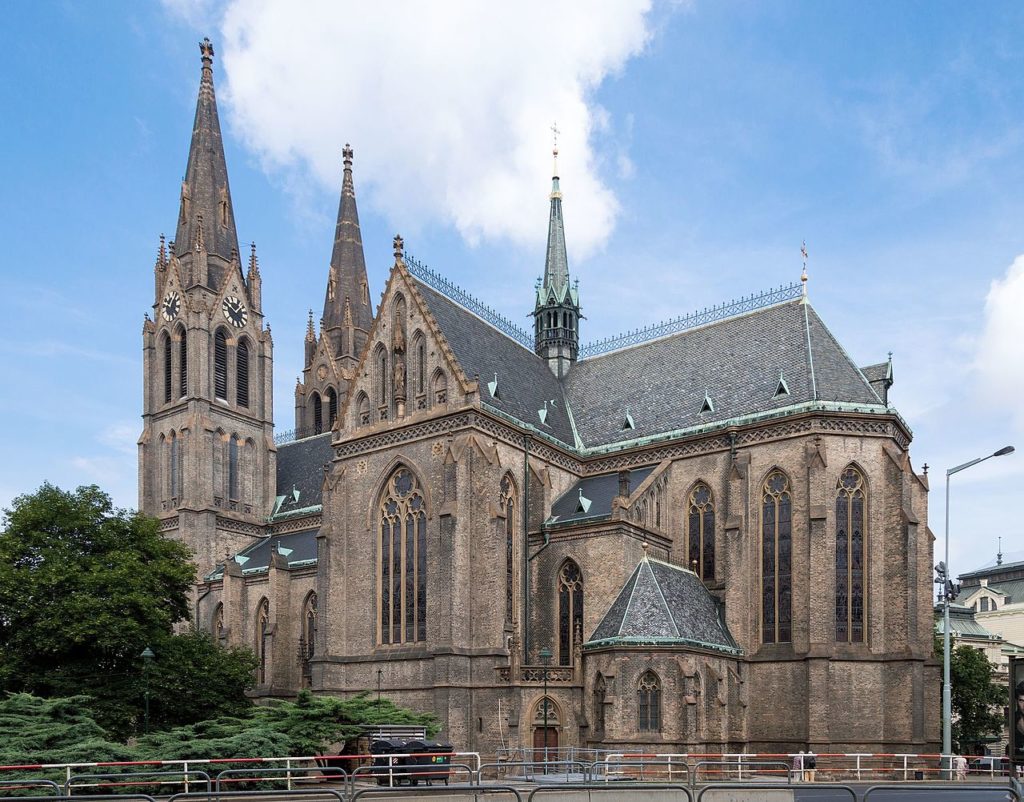
(right) Photo by Sergey Ashmarin from Wikimedia Commons
In addition to all the other works of Revival Architecture on this list, Prague is also home to several examples of Neo-Gothic buildings. Neo-Gothic became popular, particularly with religious buildings, during the late 19th century. St. Peter and Paul’s Basilica was completed in 1903 and is located within the Vyšehrad Fortress, which is a Star Fort dating to the Baroque Age. The Church of Saint Ludmila was built from 1888-1892 and it was meant to be the main church for the expanding neighborhoods outside of Prague’s New Town.

Interested in Revival Architecture? Check out our article on the Architecture of Stockholm to see more great examples of Revival Style Buildings.
Art Nouveau Architecture in Prague
Art Nouveau was a style of architecture that was popular in Europe from 1890-1910. Although not as big in Europe after this point, Prague still contains several late examples of this building style, some of which date to the 1930s. Art Nouveau was a unique style that emerged from the Classical Revival Architecture of the 19th century. Architects grew tired of replicating older building styles such as Gothic and Renaissance, and instead, they wanted to create a modern innovative style that took full advantage of new 20th-century materials and methods.
Art Nouveau Architecture utilizes organic undulating curves, idealized figures of humans plants, and animals, as well as dynamic color pallets with muted shades of several different colors. Art Nouveau also had a strong impact on the illustrations, paintings, and sculptures of the age. Art Nouveau was also one of the first art movements to be experienced throughout everyday life. Newspapers, magazines, furniture, and lighting were all part of the Art Nouveau Movement. Some of the finest examples of the reach of this movement include the popular posters designed by Henri de Toulouse-Lautrec and the stained glass lamps designed by Tiffany & Co.
You can check out this great Art Nouveau Documentary to learn more!
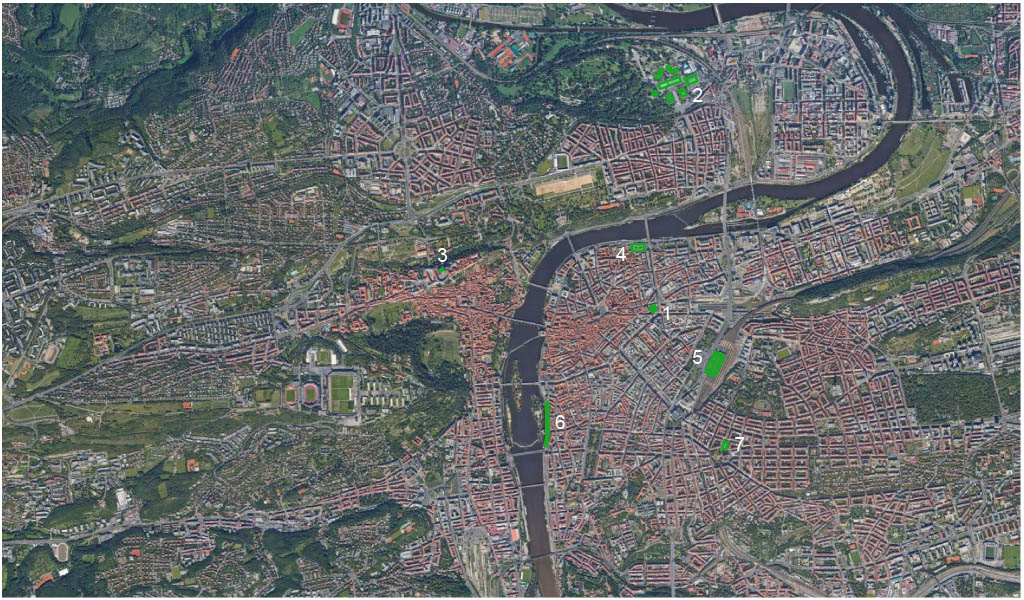
Map of Prague highlighting important works of Art Nouveau architecture within the city.
1. Prague Municipal House

The most iconic example of Art Nouveau Architecture within the city is the Prague Municipal House. Construction lasted from 1905-1912. The plan of the building loosely corresponds with the former medieval walls that once enclosed Prague’s Old Town. The Powder Tower is one of the few remaining portions of the Gothic-Era walls, and a portion of the tower can be seen to the left side of the image above. The front facade of the Municipal House features several of the main elements of Art Nouveau such as organic curves, particularly in the wrought ironwork above the main entrance.
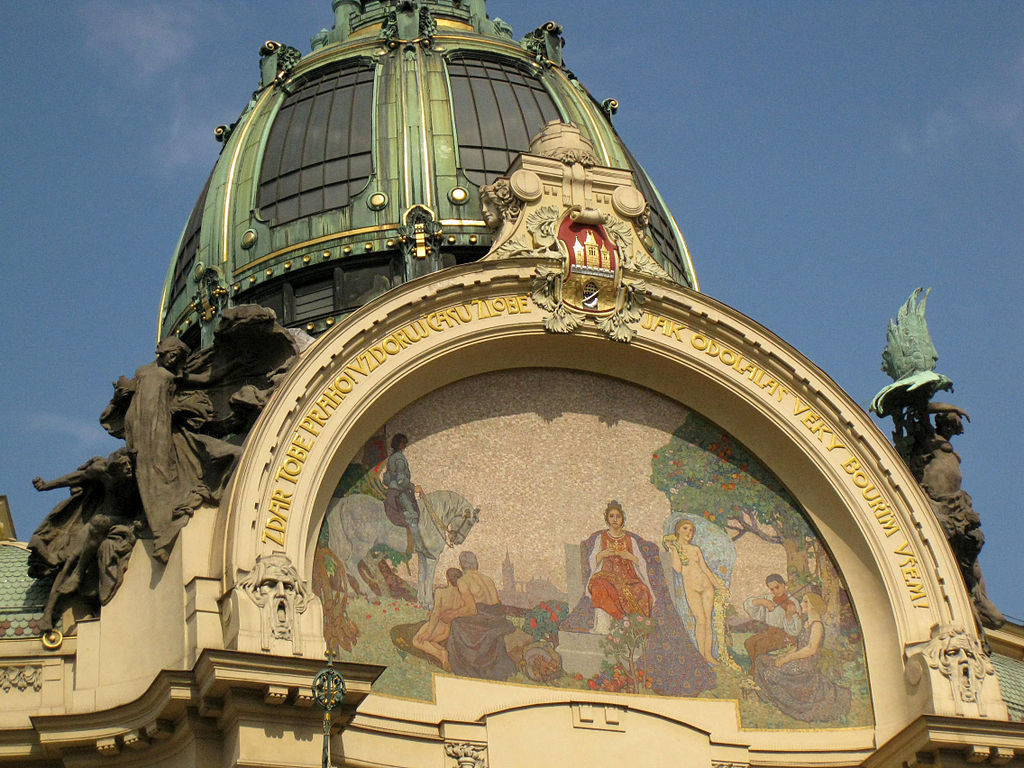
The exterior of the Prague Municipal House is also opulently decorated with Art Nouveau Artwork. There is an allegorical mosaic within the main front archway that is entitled Homage to Prague. On either side of the mosaic, there are metal statues and on top of the roof, there is an ornate dome made from glass, steel, and copper. The building today is used for a variety of functions, including an event space, offices, and restaurants. The first floor of the Municipal House is also home to one of Prague’s most beautiful historic cafes. The Kavárna Obecní dům is a storied coffee shop known for its Art Nouveau Decor and Furniture. Many people flock to the cafe to catch a glimpse of the ritzy lavish lives of the elite living in Prague during the age of Art Nouveau.
2. Výstaviště Praha
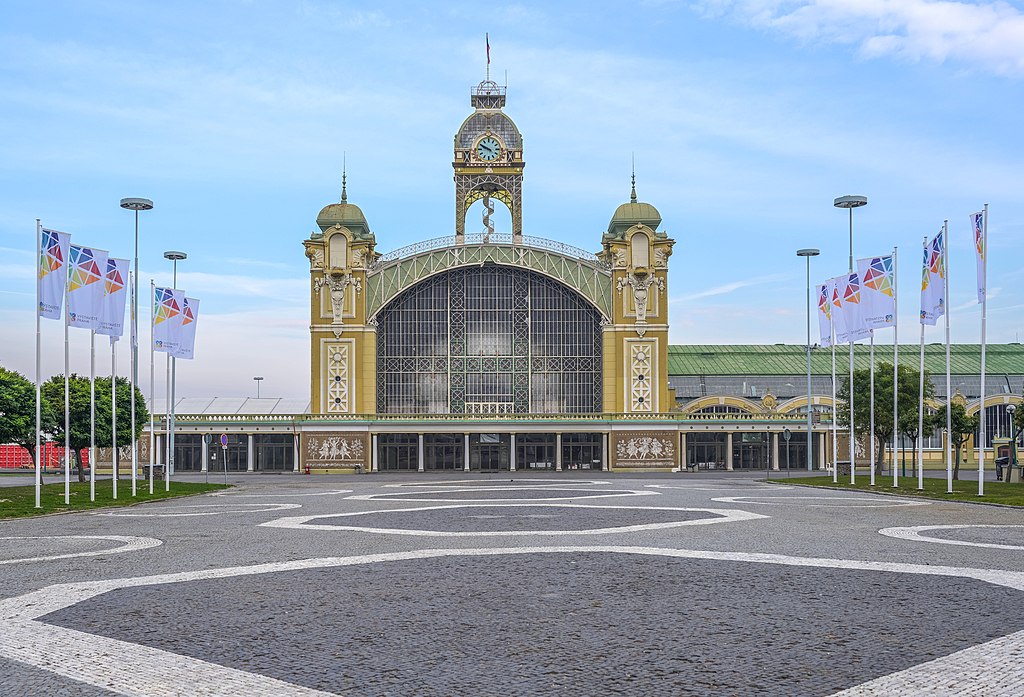
In 1891 Prague founded the Výstaviště Praha, which is a massive complex of buildings used for celebrations, exhibitions, and other large gatherings. Similar to the grounds for a World’s Fair, there are a variety of different buildings serving different functions located within the compound. The industrial palace is the centerpiece of the entire area. It was built in the Art Nouveau Style, a form of architecture known for its frilly and organic-looking details. The main clock tower of the building is particularly indicative of the Art Nouveau Style. The building was an early example of steel being used in construction, which created the opportunity for glass walls that let in lots of natural light.

Another remarkable building within the Výstaviště Praha, is the Lapidarium, an archeological museum focusing on historic artifacts made from stone. It is also built in the Art Nouveau Style with elements of Art Nouveau Architecture mixed with some more traditional Baroque forms. Today the Lapidarium houses an incredible collection of statues, tombs, and other stone objects, most of which were found in and around Prague. One of the highlights of the collection is the Baroque Style Statues of Charles Bridge. The originals are kept here out of the elements while replicas currently stand in place on the actual bridge in the city center.
3. St. Vitus Cathedral Stained Glass by Alphonse Mucha


During the late 19th century, an incredible push was made to complete St. Vitus Cathedral, which had remained unfinished for centuries. While much of the work was done in the Neo-Gothic style some of the finishing touches on the church were completed in the early 20th century using Art Nouveau designs. Alphonse Mucha was commissioned to design a stained glass window within the church in 1931. Although the actual geometry of the window is Gothic, the images within the glass are completely new and modern. The glass features rich colors, idealized figures, and intense organic curvatures, all distinct elements within Art Nouveau. Alphonse Mucha was one of the principal artists within the Art Nouveau Movement in Prague. Mucha was famous for his illustrations which were found in many publications in the city. You can check out this website for a complete collection of the works of Alphonse Mucha.
4. Ministry of Industry and Trade of the Czech Republic

The Ministry of Industry and Trade of the Czech Republic is an Art Nouveau Building constructed along the banks of the Vltava River. The building was designed by Josef Fanta, who was a prominent architect that also designed Prague’s main railway station. Construction on the Ministry of Industry and Trade Building began in 1928 and lasted until 1934. It, therefore, is one of several Art Nouveau Buildings in Prague built after the main Art Nouveau Period. The iconic glass dome of the building was a technological innovation at the time, and many Art Nouveau Buildings throughout Europe feature some sort of redesigned dome that’s meant to break away from the standard classical domes from antiquity.
5. Praha Hlavní Nádraží
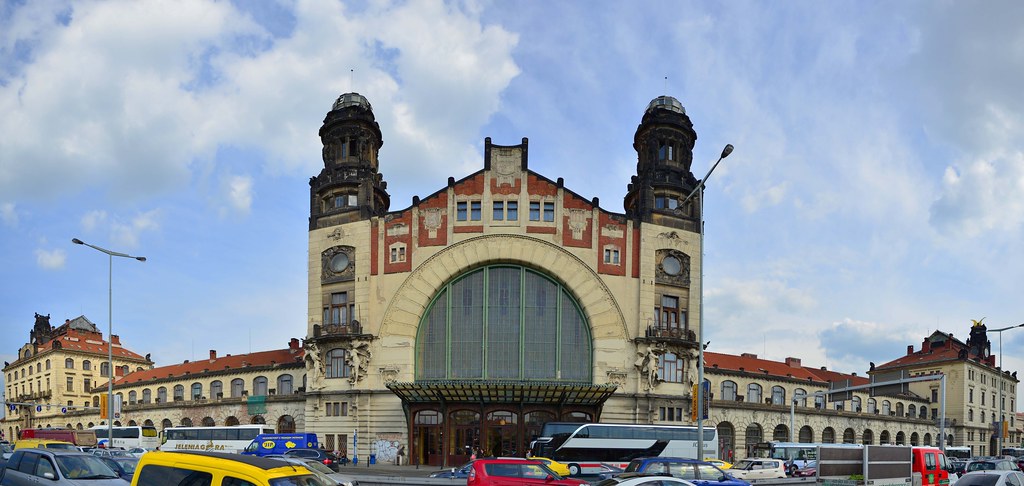
Prague’s Main railway station, known as the Praha Hlavní Nádraží, was designed in the Art Nouveau Style by Josef Fanta. The name of the station directly translates to “Prague Main Railway Station” although it was originally named Franz Josef Station after the final ruler of the Austro-Hungarian Empire. The main entrance has a typical Art Nouveau-Style glass canopy over the doorways, and the massive grand archway on the front facade is flanked by human figures that are intricately carved in a style full of movement and fluidity.
6. Facades of Masarykovo Nábř


Right Photo by VitVit from Wikimedia Commons
Nové Město which translates to New Town in English, is one of several neighborhoods within the historic center of Prague. It’s located just beyond the Old Town, and it saw a massive expansion during the late 19th and early 20th centuries. The border of the New Town with the Vltava River is marked by a road known as Masarykovo Nábř in Czech. Because of the street’s location overlooking the river, many of Prague’s wealthy noble families built impressive residences lining the roadway. These various buildings are a great example of the Art Nouveau style and they all feature the imagery, color, and details found throughout Art Nouveau Architecture.
7. Vinohrady Theater
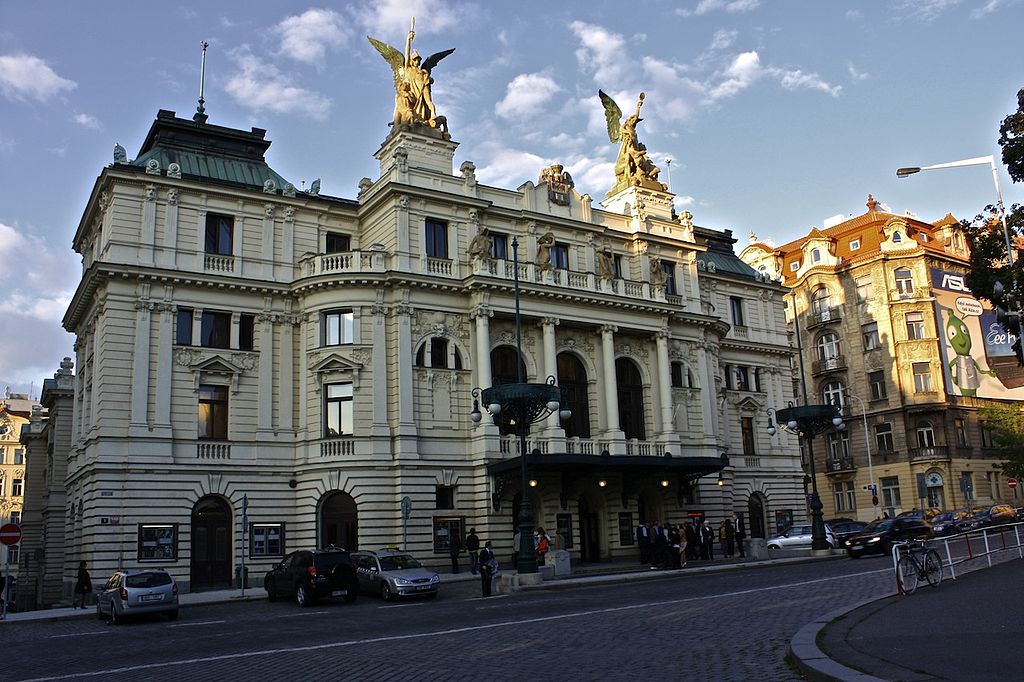
Vinohrady Theater is one of several important theaters located within Prague in addition to the Prague National Theater and the Rudolfinum. All of these theaters help contribute to the vibrant arts scene that has existed in Prague for centuries. The architecture of Vinohrady Theater is a little more reserved and restrained when compared to other Art Nouveau Buildings within the city. The exterior is pretty void of colors, and it borrows many elements from traditional classical architecture. However, you can still see the eye-catching Art Nouveau Sculptures of winged angels at the top of the building which is the exterior’s most notable feature.
Modern Architecture in Prague
Because Prague emerged largely unscathed from the bombs of WWII its historic center is remarkably well preserved. There are few examples of modern architecture. There are only a few newly constructed buildings scattered throughout the city, and it’s much more common to see renovations and additions to older buildings. Despite the lack of inventory, some contemporary buildings in Prague are unique featuring styles of architecture that have evolved over the decades. Of course, Prague’s history and the history of the Czech People are common themes throughout these modern structures, and in a way, the modern architecture of Prague can be seen as some of the most important Czech Architecture ever built. The buildings in the list below were all built in an era when Prague was the capital of a thriving independent nation, first as Czechoslovakia, and now as the modern Czech Republic.

Map of Prague highlighting various works of Modern Architecture within the city.
Note: #5 on the list is not depicted
1. Dancing House

By far the most infamous example of modern architecture in Prague is the Dancing House. Designed by Frank Gehry, The Dancing House is meant to resemble two figures dancing. The Man, on the right, is stiff and sturdy, while the woman on the left, appears graceful and flowing. The two figures are nicknamed Fred and Ginger and together they make one cohesive building which has been a cherished work of art on Prague’s skyline since it was completed in 1996. The Dancing House sits along the same strip of the Vltava Riverfront as Masarykovo Nábř, a street where much of the city’s Art Nouveau Architecture is located.
2. Emmaus Monastery
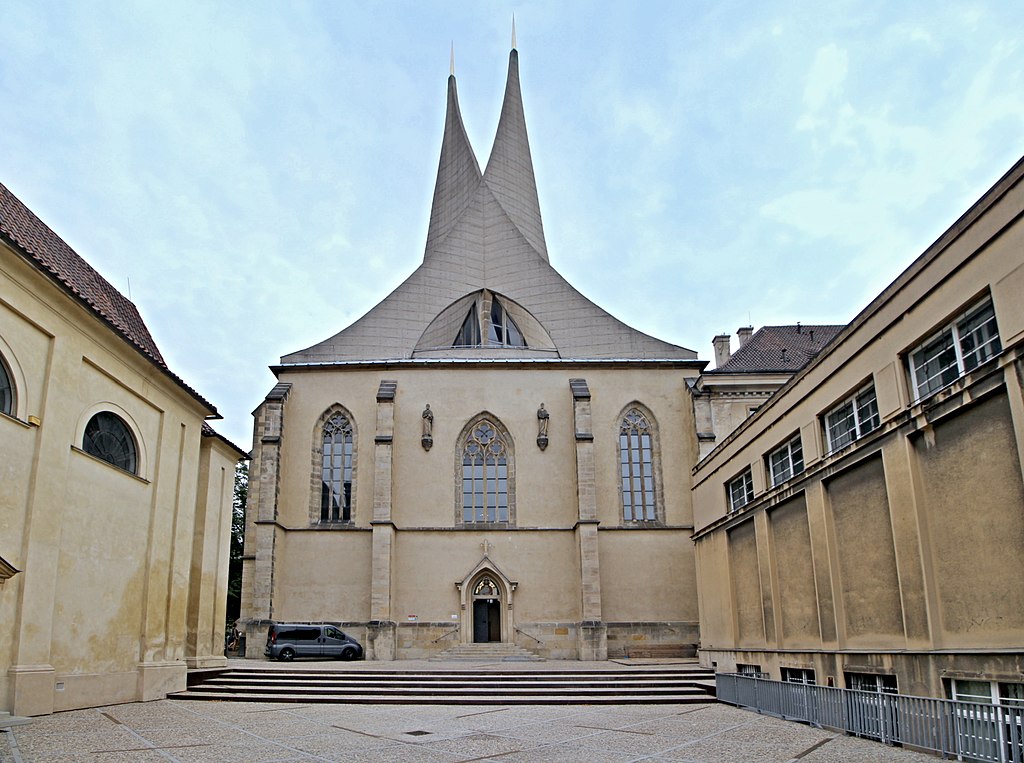
Dating originally to the mid-14th century, the Emmaus Monastery is located within the New Town of Prague, just south of the Dancing House. The main building dates to the Gothic Age, when the monastery was founded, and a few of the adjacent buildings were built during the Baroque Age. The roof of the chapel was bombed during WWII in an airstrike by Allied Forces attacking the German-occupied city. It was one of only a few raids in Prague, but it still illustrates the devastation of the bombs of the war. In the 1960s, a renovation to the building added new towers and replaced the entire roof. The elegant curves of the new towers are a nice design that contrasts the Gothic Base of the building rather than trying to blend in.
3. Villa Muller
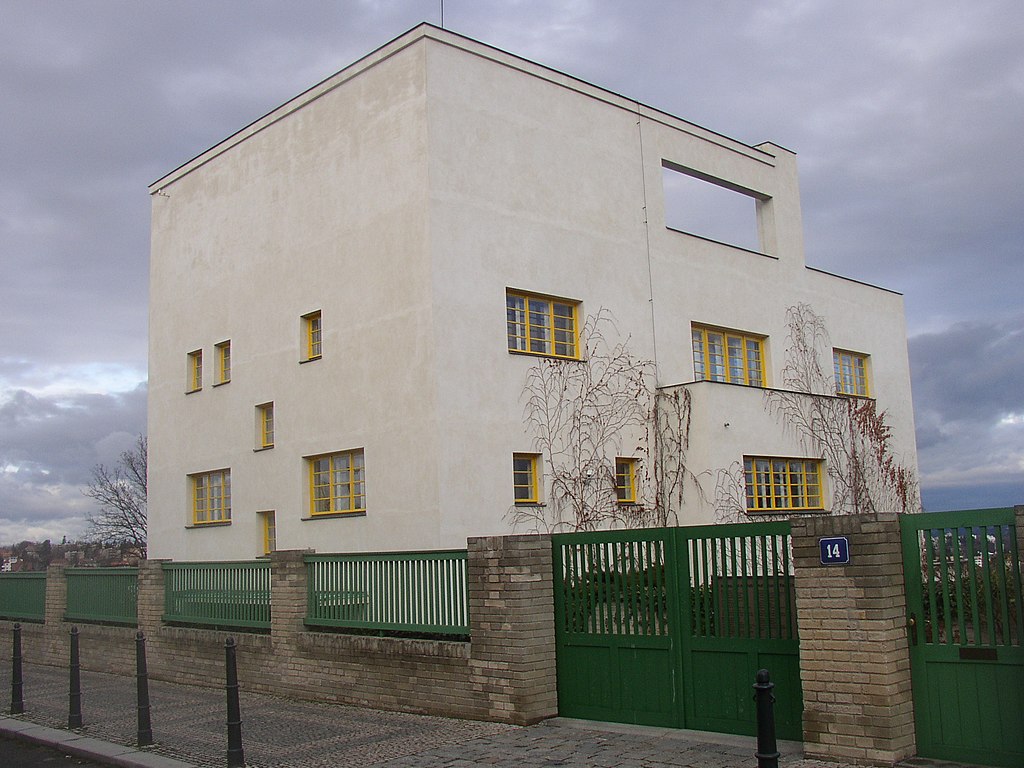
Although built before WWII in 1930, Villa Muller is still a very modern-looking building. It was designed by an architect named Adolf Loos, who was an Austrian-born designer and writer who worked throughout the Modernist Movement. He wrote a famous essay entitled Ornament and Crime that pushed for sleek smooth surfaces and straight rectangular forms. His writing and his designs were important to the evolution of Modernism throughout Central Europe. Villa Muller exemplifies all of the key aspects of Adolf Loos’ teachings on architecture. The flat white walls, rectangular forms, and the square windows that don’t align all combine to create one of the most iconic works in Modernist Architecture.
4. Žižkov Television Tower
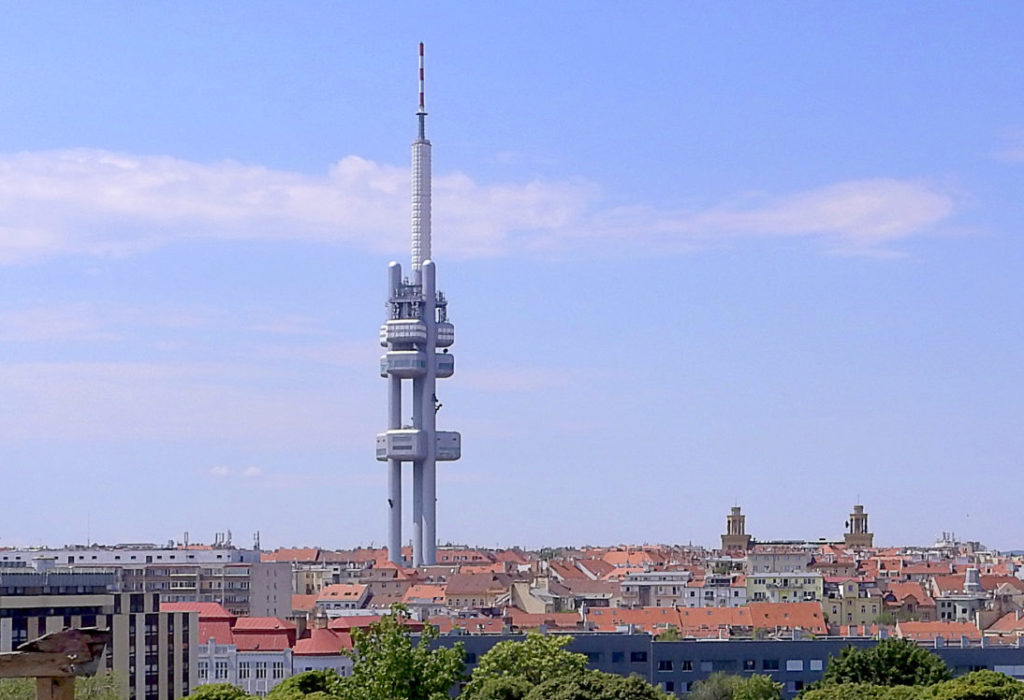
After WWII Prague remained as the capital of an independent Czechoslovakia, but the entire nation still remained within the sphere of Soviet influence that occurred during the second half of the 20th century. The Žižkov Television Tower is a work of Soviet-era Architecture that was completed in 1992. It’s one of the most well-known buildings in all of Prague, thanks to its dominant size and towering appearance. Many locals feel that the futuristic design of the building is a bit of an eye-soar, and some have even petitioned for the demolition of the structure. Although controversial, the tower is a reminder of the varying powers that have influenced Prague, and how the city has grown into its current self.
5. Prague’s Public Art

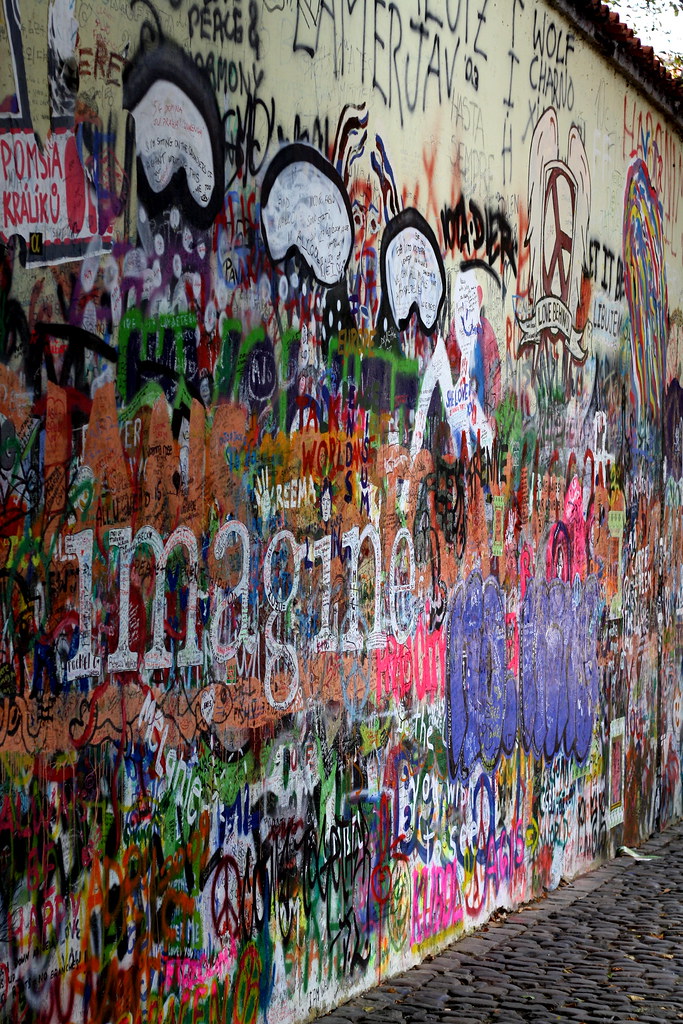
Although Prague isn’t known for its many modern buildings, the city makes up for that with an abundance of modern art. Throughout the city, there are dozens of examples of public art that are both fun and thought-provoking. The left image above shows an art piece inspired by the literary works of Franz Kafka. Kafka was a renowned writer, known for his obscure and metaphorical books such as The Trial and Metamorphosis. The right image above shows a small portion of the John Lennon Wall. This is a popular spot for Graffiti Artists who are welcome to paint wherever they please along the wall. It was popularized in 1980, when an artist created a massive portrait of John Lennon on the wall, immediately following the singer’s assassination.
Neighborhoods of Prague
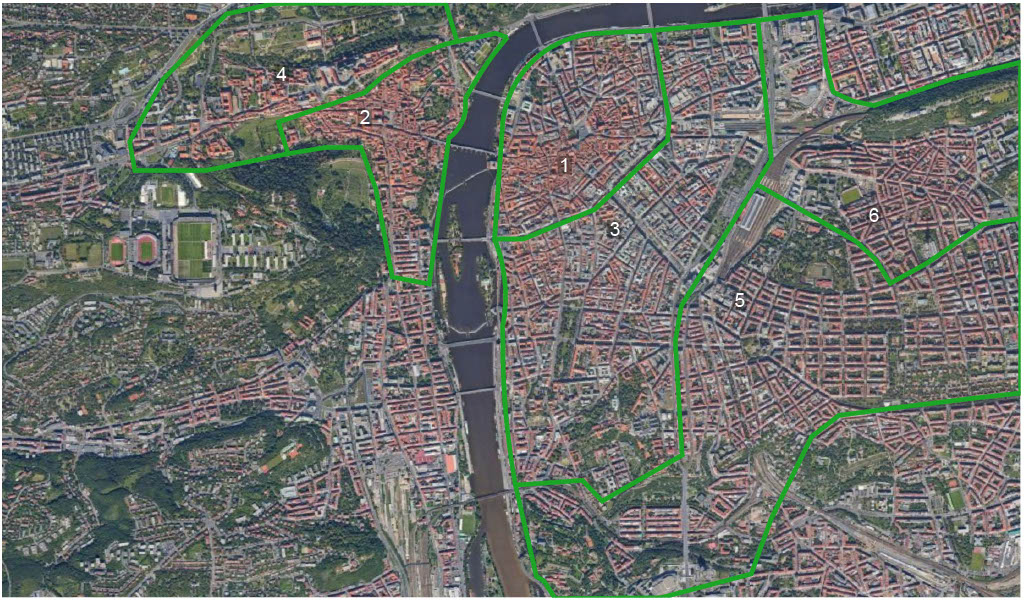
Map of Prague Showing the extents of various neighborhoods within the city
.

1. Old Town (Staré Město)
Prague’s Old Town marks the original medieval settlement that existed within the city. It was once enclosed by the Medieval Walls that were built in the Gothic age. The Old Town contains a great majority of the historic architecture within the city, including the Old Town Square and the Church of Our Lady Before Týn. The Old Town is Prague’s most popular neighborhood for tourism and it is filled with stores, restaurants, bars, and other attractions.

2. Lesser Town (Malá Strana)
Prague’s Lesser Town is located across the Vltava River from the Old Town. The original crossing point was the Charles River Bridge which still shuffles pedestrians between the two neighborhoods to this day. The Lesser Town is built just below Prague Castle and it contains many great buildings such as the St. Nicholaus Church.

3. New Town (Nové Město)
Prague’s New Town is built surrounding the city’s historic center. It contains buildings from as early as the Gothic Age but overall is much more modern than the adjacent Old Town. New Town is known for its busy streets and roads, and the commercial hub of Wenceslaus Square. Some other important works of architecture from the New Town include the Prague Municipal House and Frank Gehry’s Dancing House.
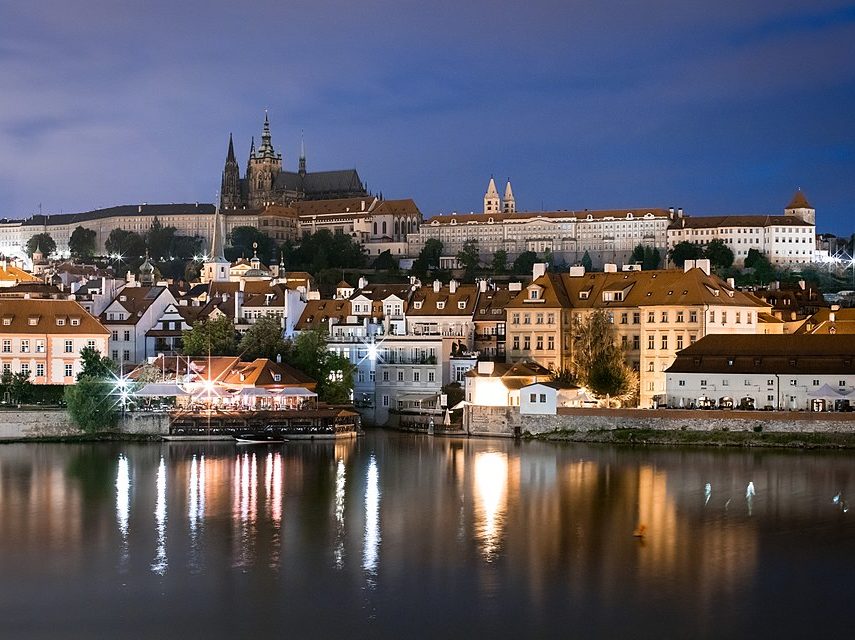
4. Castle District (Hradčany)
The Castle District is located just above the Lesser Town on the West bank of the Vltava. The district contains Prague Castle in its entirety, and also the immediate surroundings of the castle. Located atop a large hill with excellent views of Prague, this area is great for so much more than just visiting Prague Castle. A few of the major buildings within the area including Schwarzenberg Palace and the Archbishop’s Palace..

5. Vinohrady & Vyšehrad
Vinohrady & Vyšehrad are two of the newer neighborhoods within Prague. They are located along the Vltava River, just south of the New Town. Vyšehrad is named after Vyšehrad Fortress, which is a large Baroque-Age fort that was once part of the city’s walls. Vinohrady & Vyšehrad are a little more residential than the other neighborhoods located within the city center, but they are still full of plenty of bars and nightlife.

6. Žižkov & Florenc
Žižkov & Florenc are two other small neighborhoods located east of the new town. Florenc tends to be a little more industrial than the rest of Prague, and it contains one of the city’s busiest transportation hubs, known as the Florenc Bus Terminal. Žižkov is another residential neighborhood that is also home to a few important works of architecture such as the National Memorial on Vítkov Hill and the Žižkov Television Tower.
Architecture of Prague: In Review
Prague has been one of the leading cities in Europe since the Middle Ages, and as a result, the city features buildings from every major architectural age. From the incredible Gothic Monuments of King Charles IV, to the many Baroque works of the Hapsburg Monarchs to the innovative buildings of the modern Czech Republic, Prague is home to countless examples of great architecture. It also happens to be one of the best-preserved cities in all of Europe, thanks to it avoiding the bombs of WWII. Today, a visit to Prague is almost like a visit back in time, to the days of medieval Europe before the drastic changes of the modern age. For all of these reasons, Prague and its many monuments were enshrined as a UNESCO World Heritage Site in 1992. Prague is a fantastic destination for any architectural enthusiast and is certainly worth a visit for anyone who wants to see some incredible buildings.

- About the Author
- Rob Carney, the founder and lead writer for Architecture of Cities has been studying the history of architecture for over 15 years.
- He is an avid traveler and photographer, and he is passionate about buildings and building history.
- Rob has a B.S. and a Master’s degree in Architecture and has worked as an architect and engineer in the Boston area for 10 years.
Like Architecture of Cities? Sign up for our mailing list to get updates on our latest articles and other information related to Architectural History.


